Talk to our experts
1800-120-456-456
- Vikram Sarabhai Biography


Who is Vikram Sarabhai?
On August 12, 1919, Vikram Sarabhai was born in Ahmedabad, India. His full name is Vikram Ambalal Sarabhai and he was the son of Ambalal Sarabhai who was a Gujarati industrialist. Dr. Vikram Ambalal Sarabhai was an Indian physicist and an astronomer who started the space research organization and initiated the nuclear power plant in India. Because of his achievement, he is regarded as the Father of the Indian space program. He was honoured with Padma Bhushan in 1966 and the Padma Vibhushan in 1972. Vikram Sarabhai passed away on December 30, 1971, in Kovalam.
In this article on Vikram Sarabhai biography, we are going to discuss who is Vikram Sarabhai, Vikram Sarabhai education, and the achievements he accomplished throughout his life.
Vikram Sarabhai Information
Full Name : Vikram Ambalal Sarabhai
Date of Birth: August 12, 1919
Death Date: December 30, 1971
Cause of Death: Cardiac arrest
Age(at the time of death): 52
Information about Vikram Sarabhai
Vikram Sarabhai was born on August 12, 1919, in a Gujarati industrial family. His father’s name was Ambalal Sarabhai who was an industrialist, a philanthropist, and the founder of the Sarabhai group of companies. His mother’s name was Sarla Devi and he was the Eighth son of Ambalal Sarabhai. In 1942, Vikram Sarabhai married Mrinalini who was a classical dancer by profession. The couple had two children. His daughter’s name is Mallika, who went on and became an actress and an activist. His son’s name is Kartikeya who is one of the world’s leading environmentalist educators and a dedicated community builder, he was awarded the Padma Shri in 2012. During his lifetime, Vikram Sarabhai practised Jainism and had dedicated his life to building the Indian space program and that is why he is called the Father of the Indian space program.
Vikram Sarabhai Education
Vikram Sarabhai came from the famous Sarabhai family who was a major industrialist committed to the Indian Independence movement. V ikram Sarabhai attended the Gujarati college in Ahmedabad to complete his higher studies and after doing so he then took admission to the University of Cambridge in England where in 1940, he gave his final honour exam in the Natural Sciences.
Sarbhai returned to Cambridge post world war 2 to pursue his doctorate and in 1945 he submitted a thesis on “Cosmic Ray Investigation in Tropical Latitudes”.
Vikram Sarabhai Achievements
Dr. Vikram Sarabhai is considered the father of the Indian space program. He was a great institution builder and helped in establishing a large number of institutions in diverse fields. After returning from Cambridge in 1947, he requested his friends and family members to help him in opening a research institution near his home in Ahmedabad, thus at the age of only 28, he founded the Physical Research Laboratory (PRL) in Ahmedabad on November 11, 1947.
The Physical Research Laboratory was the first of many institutions which Vikram Sarabhai created and cultivated. He served in the Physical Research Laboratory from 1966 to 1971.
Vikram Sarabhai was also very active in his family’s industry and the business which it had. After Independence in 1947, Vikram Sarabhai founded the Ahmedabad Textile Industry’s Research Association and then actively looked after it until 1956. Seeing the immediate need for management professionals in the country, Vikram Sarabhai also helped in setting up the Indian Institute of Management at Ahmedabad in 1962.
The Indian National Committee for Space Research (INCOSPAR) which was later renamed the Indian Space Research Organization(ISRO) was established by Vikram Sarabhai in 1962.
After the death of t he beloved physicist Homi Bhabha in 1966, Vikram Sarabhai was appointed as the chairman of the Atomic Energy Commission of India. He is also credited for setting up the Thumba Equatorial Rocket Launching Station in Southern India. Vikram Sarabhai also helped in developing indigenous nuclear technology for defence.
Vikram Sarabhai Discoveries
Vikram Sarabhai helped in setting up many institutions all around the country and here are some of the well-known institutions established by Dr. Vikram Sarabhai.
In 1947, Vikram Sarabhai established the Physical Research Laboratory (PRL) in Ahmedabad. PRL is a National Research Institute for space and allied sciences.
Indian Institute of Management (IIM), Ahmedabad founded on 11 December 1961 is considered to be the best institute of management in the country.
Uranium Corporation of India Limited (UCIL), Jaduguda, Bihar was founded in 1967, under the department of atomic energy.
Vikram A. Sarabhai Community Science Centre (VASCSC) or the Community science centre was established in 1960 at Ahmedabad. VASCSC is working towards popularizing science and mathematics education among students, teachers, and the public. Its main objective is to improve and find innovative methods of scientific education.
Darpan Academy for Performing Arts, Ahmedabad was founded in 1949 along with his wife and now directed by his daughter Mallika Sarabhai for the last three decades.
Faster Breeder Test Reactor (FBTR), Kalpakkam was founded in 1985 and it is the testbed for fast fuel reactors and materials.
Electronics Corporation of India Limited (ECIL), Hyderabad was founded in 1967 to create a strong indigenous base in electronics.
Vikram Sarabhai Space Centre, Thiruvananthapuram founded on 21 November 1963, is a major space research centre of the ISRO which mainly focuses on rocket and space vehicles for the Indian satellite program.
Space Applications Centre( SAC), Ahmedabad was founded in 1972. The Space Applications Centre has played an important role in realizing the vision and the mission of ISRO.
Variable Energy Cyclotron Project or the VECC is located in Calcutta and was founded in 1972. VECC performs research in basic and applied nuclear sciences and the development of the nuclear particle accelerator.
Vikram Sarabhai Inventions/Indian Space Research Organization
The establishment of the Indian space research organization by Vikram Sarabhai is considered to be his greatest achievement. When he returned to India after completing his Doctorate from Cambridge University in London in 1947, he was able to convince the newly formed independent Indian government of the importance of a space program for a developing country like India. Dr. Sarabhai was also supported by Dr. Homi Jehangir Bhabha who is widely regarded as the father of the Indian nuclear science program. He supported Dr. Sarabhai in setting the first rocket launch station in India. At Thumba near Thiruvananthapuram on the coast of the Arabian sea, the first rocket launch centre was established
The inaugural flight was launched on November 21, 1963, with sodium vapour payload after a remarkable effort in setting up the infrastructure, personnel, communication links, and launch pads.
Dr. Vikram Sarabhai was constantly in negotiations with the other leading country’s space organization such as NASA and because of his efforts, the Satellite Instructional Television Experiment (SITE) was launched during July 1975 - July 1976.
Dr. Vikram Sarabhai was very much interested in science education and founded the Community Science Centre at Ahmedabad in 1956. It is also called Vikram Sarabhai Community Science Centre (VASCSC). He also started a project for the fabrication and the launch of an Indian satellite.
Vikram Sarabhai worked very passionately to ignite India’s first satellite, Aryabhatta but unfortunately, he passed away four years before the launch of the satellite. Dr. Vikram Sarabhai was honoured with Padma Bhushan in 1966 and Padma Vibhushan in 1972 to remember and celebrate his life and the legacy he left behind.

FAQs on Vikram Sarabhai Biography
Q1: When Did Vikram Sarabhai Die?
Ans: Vikram Ambalal Sarabhai was a gem of India and he passed away on 30 December 1971 due to cardiac arrest at Halcyon Castle, Kovalam, Kerala.
Q2: What is Dr. Vikram Sarbhai known for?
Ans: Dr. Vikram Sarabhai is called the father of the Indian space organization and he is also known for laying the foundation stone for many institutes in India like the Indian Institute of Management Ahmedabad.
Q3: Who was the First Chairman of the Indian Space Research Organisation(ISRO)?
Ans: Dr. Vikram Sarbhai was the first chairman of the Indian space research organization.

Vikram Sarabhai Biography, Birth Anniversary, Invention, Awards & Honors
Vikram Ambalal Sarabhai was an Indian physicist and astronomer who initiated space research and helped develop nuclear power in India. Read all about Vikram Sarabhai in this article.
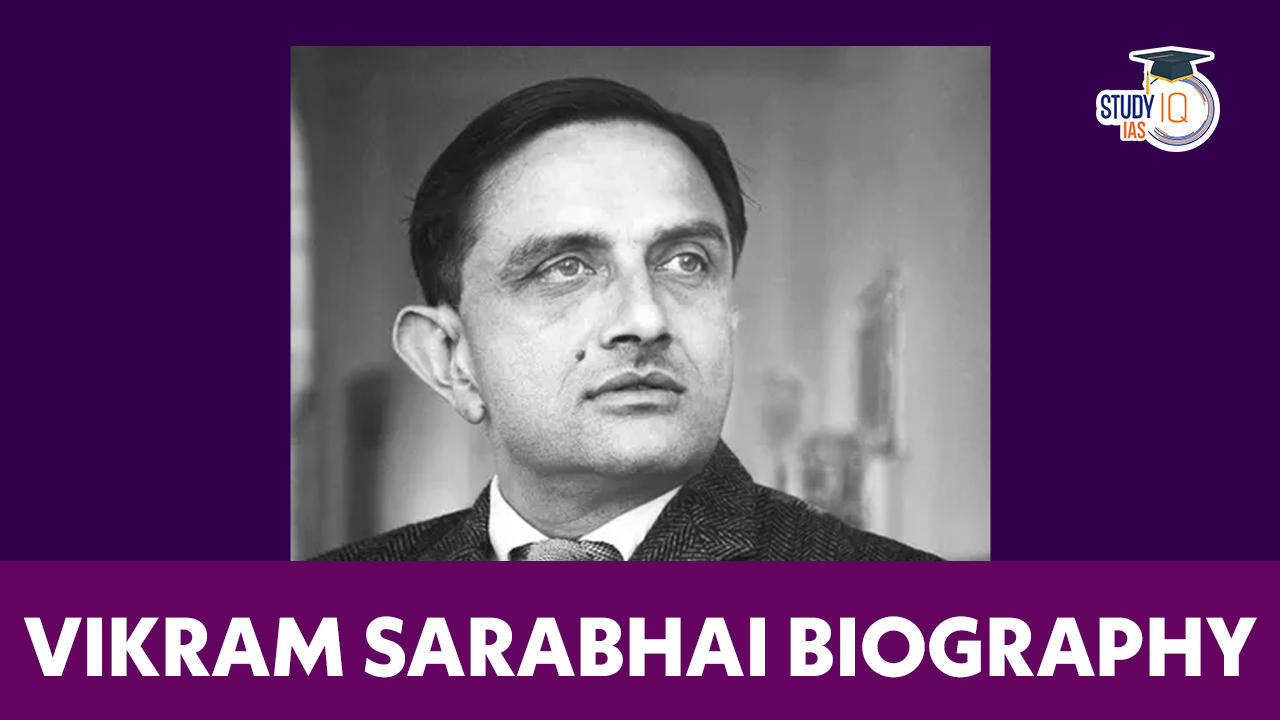
Table of Contents
Vikram Sarabhai
Vikram Sarabhai, an eminent scientist, visionary, and the founding father of the Indian space program, left an indelible mark on the world of science and technology. His unwavering dedication, pioneering vision, and relentless efforts have played a pivotal role in shaping India’s journey into space exploration. This article explores the life, achievements, and legacy of Vikram Sarabhai, highlighting his contributions to space research and technology.
Who is Vikram Sarabhai?
Vikram Sarabhai (12 August 1919 – 30 December 1971) was one of the greatest scientists in India. He is renowned as the Father of the Indian space program, encompassing roles of a scientist, innovator, industrialist, and visionary. His contributions extended to establishing the Physical Research Laboratory (PRL) and chairing the Atomic Energy Commission.
Alongside fellow Ahmedabad-based industrialists, he was pivotal in founding the Indian Institute of Management, Ahmedabad. A prolific institution builder, he founded or aided in creating an impressive 42 institutes spanning fields like Science, Industry, Management, and Education. Instrumental in forming the Indian Space Research Organization (ISRO), his legacy resonates through his multifaceted accomplishments.
Read about: Sarojini Naidu
Vikram Sarabhai Education and Early Life
Vikram Sarabhai emerged into the world as one of eight siblings in a privileged family of forward-thinking industrialists. His early schooling transpired within the nurturing corridors of “Retreat,” a private Montessori institution founded and guided by his parents. Set against the backdrop of a politically charged environment, he grew up amid India’s elite, instrumental in securing the nation’s independence and subsequently orchestrating its inaugural governments. This immersive upbringing acquainted him with notable figures, including interactions with Congress Party stalwarts like Jawaharlal Nehru. His familial network extended to spirited activism—his mother, Sarladevi, championed social causes and Montessori education, while his sister ventured into political activism. His aunt, Ansuyaken, emerged as a leader in the national labor movement.
Having completed his studies at Gujarat College in Ahmedabad in 1937, Vikram embarked on a journey to England for advanced education. He matriculated at the venerable St. John’s College, University of Cambridge, culminating in the attainment of the Tripos in Natural Sciences in 1939. As the shadows of World War II loomed, he returned to India, enrolling at the Indian Institute of Science in Bangalore. Under the sagacious guidance of the esteemed scientist C.V. Raman, he delved into pioneering research on cosmic rays, ultimately authoring his inaugural scientific publication, “Time Distribution of Cosmic Rays,” in 1942.
In 1942, he entered into matrimonial union with the renowned classical dancer, Mrinalini. Their partnership flourished, yielding two offspring who, in time, would carve their own niches in the world of prominence. Noteworthy among them, his daughter Mallika and son Karthikeya emerged as accomplished individuals in their own right. Intriguingly, his spouse, Mrinalini Sarabhai, bore a kinship with India’s freedom fighter and revolutionary, Dr. Laxmi Sahgal. The Sarabhai clan’s leisure pursuits often led them to the tranquil embrace of the Himalayas. Here, Vikram astutely recognized the fertile grounds high altitudes provided for the study of cosmic rays, a realization that led to his strategic deployment of cosmic ray counters during these sojourns.
It was amidst the sublime landscapes of Gulmarg, near Alpathari Lake, in 1943 that Vikram’s aspirations coalesced into a visionary concept—a dedicated laboratory focused on cosmic and atmospheric physics. A return to Cambridge in 1945 further honed his expertise in cosmic ray investigations, culminating in the conferment of his doctoral degree for his scholarly dissertation, “Cosmic Ray Investigations in Tropical Latitudes.”
His influence radiated across geographical boundaries. During a visit to Thiruvananthapuram, he participated in the foundation stone laying ceremony of the Thumba railway station, a critical component supporting the newly established Thumba Equatorial Rocket Launching Station.
Read about: Bhagat Singh
Vikram Sarabhai Birth Anniversary and Legacy
Every year on August 12th, India celebrates the birth anniversary of Vikram Sarabhai as National Science Day. This day serves as a reminder of his enduring legacy and his significant role in propelling India’s technological advancement. Sarabhai’s unparalleled vision prompted the establishment of several research institutions, with the Vikram Sarabhai Space Centre (VSSC) being a standout accomplishment.
Read about: Subhash Chandra Bose
Vikram Sarabhai: Contributions and Inventions
Upon his return to India in the post-independence era, Vikram Sarabhai keenly perceived the dearth of robust scientific infrastructure. Harnessing the influence of the charitable trusts under his family’s stewardship, he orchestrated the establishment of pivotal institutions that would redefine India’s scientific landscape.
Notably, in November 1947, Sarabhai played a pivotal role in birthing the Physical Research Laboratory (PRL) in Ahmedabad. With atmospheric scientist K.R. Ramanathan as its founding director, PRL evolved into a distinguished research institution specializing in cosmic rays and space sciences. The foundation was laid within the confines of M.G. Science Institute, an educational bastion his parents had founded. Bolstered by support from the Council of Scientific and Industrial Research (CSIR) and the Department of Atomic Energy, PRL burgeoned into a scientific powerhouse.
The pivotal juncture of 1957-1958 marked the International Geophysical Year (IGY), a turning point that exposed Sarabhai to the uncharted domain of space science following the launch of Sputnik-I. Galvanized by this, the Indian National Committee for Space Research emerged, with Vikram Sarabhai at its helm. His strategic initiatives extended to education, notably as the founding director of the Indian Institute of Management (IIM), Ahmedabad, which he co-pioneered with businessman Kasturbhai Lalbhai in 1961. Another pioneering endeavor was the creation of the Centre for Environmental Planning and Technology University (CEPT University) in 1962, enriching disciplines such as architecture, planning, and technology.
The 1960s were marked by the establishment of key institutions driven by Sarabhai’s vision. The Vikram A. Sarabhai Community Science Centre (VASCSC) was forged to ignite scientific and mathematical interest among students and the public. Meanwhile, the Nehru Foundation for Development (NFD), established in 1965, was dedicated to probing societal and individual development concerns.
An invaluable collaborator was Dr. Homi Bhabha, a luminary in nuclear research. Together, they propelled the launch of India’s first Rocket Launching station (TERLS) at Thumba, strategically located near the equator on the Arabian Coast. The inaugural rocket, bearing a sodium vapor payload, soared on November 21, 1963. Recognition soon followed, with the UN General Assembly acknowledging TERLS as an international facility.
Tragedy struck in 1966 with the untimely demise of Homi Bhabha, leading to Sarabhai’s appointment as Chairman of the Atomic Energy Commission. Yet, his most enduring contribution materialized in 1969—the Indian Space Research Organization (ISRO). This entity, born of his vision, aimed to advance space technology for national betterment. Sarabhai’s multifaceted impact extended to sectors beyond science, with initiatives such as the Ahmadabad Textiles Industrial Research Association (ATIRA), empowering the textiles industry. He continued this legacy of empowerment through endeavors like the Blind Men Association (BMA), providing essential support to the visually challenged.
Moreover, in tandem with his wife, Mrinalini Sarabhai, he seeded the inception of the Darpana Academy of Performing Arts. The imprint of his visionary prowess extended to institutions of note including the Faster Breeder Test Reactor (FBTR), Variable Energy Cyclotron Project, Electronics Corporation of India Limited (ECIL), and Uranium Corporation of India Limited (UCIL).
The culmination of his dialogue with NASA in 1966 was the launch of the Satellite Instructional Television Experiment (SITE) in 1975-1976, a legacy that persisted even after his passing.
Read about: Maharana Pratap
Vikram Sarabhai Space Centre (VSSC)
The Vikram Sarabhai Space Centre, founded in 1963, stands as a testament to Sarabhai’s dedication to advancing space technology in India. Located in Thiruvananthapuram, Kerala, VSSC has been instrumental in developing indigenous rockets and launch vehicles. Under his leadership, India’s first satellite, Aryabhata, was launched in 1975, marking a historic milestone in the country’s space endeavors.
Incorporating state-of-the-art facilities and a cadre of brilliant minds, VSSC nurtures a culture of innovation and exploration. Its endeavours encompass conceptualizing, designing, and validating space systems, all of which form the bedrock of India’s space accomplishments. Significantly, VSSC has been a key player in the design and advancement of launch vehicles such as the Polar Satellite Launch Vehicle (PSLV) and the Geosynchronous Satellite Launch Vehicle (GSLV). These achievements have empowered India to effectively launch satellites dedicated to communication, navigation, earth observation, and scientific investigation.
Dr. Vikram Sarabhai’s indomitable spirit is woven into the very fabric of VSSC, infusing it with a relentless pursuit of excellence and a commitment to serving national and global interests through space exploration. As a beacon of scientific innovation, VSSC continues to shape India’s space journey, ever-advancing the frontiers of human knowledge and technology, and exemplifying the profound impact of visionary leadership and dedicated pursuit of the unknown.
Read about: Chandra Shekhar Azad
Vikram Sarabhai: Awards & Achievements
- President, Physics Section, Indian Science Congress (1962): Showcased his stature in the scientific community and commitment to advancing knowledge.
- Vice-President, Fourth U.N. Conference on ‘Peaceful Uses of Atomic Energy’ (1971): Exhibited his global influence in peaceful nuclear technology.
- President, General Conference of the I.A.E.A., Vienna (1970): Underlined his significant contributions to global atomic energy cooperation.
- Vikram Sarabhai Space Centre (VSSC): A tribute to his role in shaping India’s space program, this center remains a hub for pioneering rocket propulsion research.
- Sarabhai Crater: Honored by the International Astronomical Union with a crater on the moon, cementing his legacy in space exploration.
- Shanti Swarup Bhatnagar Award (1962): Recognized for his pioneering cosmic ray research and space science contributions.
- Padma Bhushan (1966): One of India’s highest civilian honors, acknowledging his multidimensional impact on science, education, and society.
- Posthumous Padma Vibhushan (1972): Enshrined him as a visionary leader and scientific luminary in India’s history.
Read about: Mangal Pandey
Vikram Sarabhai: Passing and Legacy
Tragically, Vikram Sarabhai’s journey was prematurely curtailed as he breathed his last on December 30, 1971, at the age of 52, succumbing to a cardiac attack. His sudden departure was an irreplaceable void in the scientific realm, yet his enduring legacy persevered through the institutions he founded and the frameworks he set in motion. His pioneering notion of leveraging space technology for societal progress continues to illuminate ISRO’s path, propelling India into a commanding stature within the international space domain.
Information about Vikram Sarabhai
Dr. Sarabhai, who is regarded as the founder of the Indian space programme, was a brilliant institution-builder who founded or assisted in the establishment of numerous institutions across a wide range of areas. After returning from Cambridge to an independent India in 1947, he encouraged philanthropic trusts run by his family and friends to endow a research facility close to home in Ahmedabad, which is how the Physical Research Laboratory (PRL) came to be.
Thus, Vikram Sarabhai founded the Physical Research Laboratory (PRL) in Ahmedabad on November 11, 1947. He was only 28 at that time. Sarabhai was a creator and cultivator of institutions and PRL was the first step in that direction. Vikram Sarabhai served of PRL from 1966-1971.
Read about: Bal Gangadhar Tilak
Vikram Sarabhai UPSC
Vikram Sarabhai’s life and work continue to inspire generations of scientists, researchers, and visionaries. His pioneering efforts, coupled with his dedication to using science and technology for the betterment of society, have left an indelible mark on India’s space program. Through his visionary leadership, he ignited the spark that has propelled India’s journey into space exploration, turning his dreams into reality and laying the foundation for a brighter technological future.
Read about: APJ Abdul Kalam
Sharing is caring!
Vikram Sarabhai FAQs
Did abdul kalam worked with vikram sarabhai.
Yes, Dr. A.P.J. Abdul Kalam worked with Dr. Vikram Sarabhai, who is often regarded as the father of India's space program. Kalam was mentored by Sarabhai and played a significant role in India's space and missile development programs.
What did Vikram Sarabhai died?
Vikram Sarabhai died on December 30, 1971, due to a sudden heart attack. He was a pioneering Indian scientist and the driving force behind India's space program.
What is the difference between ISRO and VSSC?
ISRO (Indian Space Research Organisation) is the national space agency of India responsible for space research and exploration. VSSC (Vikram Sarabhai Space Centre) is a major ISRO facility focused on the development of launch vehicles and associated technologies, named after Dr. Vikram Sarabhai, the pioneer of India's space program.
What is the role of Vikram Sarabhai Space Centre?
Vikram Sarabhai Space Centre (VSSC) plays a pivotal role within ISRO by designing and developing launch vehicle technology, conducting research and testing related to space propulsion, aerodynamics, and materials, contributing significantly to India's space exploration and satellite launch capabilities.
Which is the greatest achievement of Vikram Sarabhai?
Dr. Vikram Sarabhai's greatest achievement was establishing the Indian National Committee for Space Research (INCOSPAR) in 1962, which later evolved into the Indian Space Research Organisation (ISRO). His visionary leadership and efforts laid the foundation for India's successful space program, contributing to numerous space missions, satellite launches, and technological advancements.
What is the important information about Vikram Sarabhai?
Vikram Sarabhai founded the Physical Research Laboratory (PRL) in Ahmedabad on November 11, 1947. He was only 28 at that time. Sarabhai was a creator and cultivator of institutions and PRL was the first step in that direction. Vikram Sarabhai served of PRL from 1966-1971.
I, Sakshi Gupta, am a content writer specializing in crafting SEO-optimized content to empower students aiming for UPSC, PSC, and other competitive exams. My objective is to provide clear, concise, and informative content that caters to your exam preparation needs. I strive to make my content not only informative but also engaging, keeping you motivated throughout your journey!
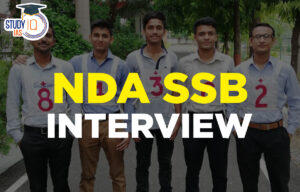
Leave a comment
Your email address will not be published. Required fields are marked *
Save my name, email, and website in this browser for the next time I comment.

- UPSC Online Coaching
- UPSC Exam 2024
- UPSC Syllabus 2024
- UPSC Prelims Syllabus 2024
- UPSC Mains Syllabus 2024
- UPSC Exam Pattern 2024
- UPSC Age Limit 2024
- UPSC Calendar 2024
- UPSC Syllabus in Hindi
- UPSC Full Form

Recent Posts
- UPPSC Exam 2024
- UPPSC Calendar
- UPPSC Syllabus 2024
- UPPSC Exam Pattern 2024
- UPPSC Application Form 2024
- UPPSC Eligibility Criteria 2024
- UPPSC Admit card 2024
- UPPSC Salary And Posts
- UPPSC Cut Off
- UPPSC Previous Year Paper
BPSC Exam 2024
- BPSC 70th Notification
- BPSC 69th Exam Analysis
- BPSC Admit Card
- BPSC Syllabus
- BPSC Exam Pattern
- BPSC Cut Off
- BPSC Question Papers
IB ACIO Exam
- IB ACIO Salary
- IB ACIO Syllabus
CSIR SO ASO Exam
- CSIR SO ASO Exam 2024
- CSIR SO ASO Result 2024
- CSIR SO ASO Exam Date
- CSIR SO ASO Question Paper
- CSIR SO ASO Answer key 2024
- CSIR SO ASO Exam Date 2024
- CSIR SO ASO Syllabus 2024
Study Material Categories
- Daily The Hindu Analysis
- Daily Practice Quiz for Prelims
- Daily Answer Writing
- Daily Current Affairs
- Indian Polity
- Environment and Ecology
- Art and Culture
- General Knowledge
- Biographies

IMPORTANT EXAMS

- Terms & Conditions
- Return & Refund Policy
- Privacy Policy

Sign Up Today
Start your 14 day free trial today

The History Hit Miscellany of Facts, Figures and Fascinating Finds
- 20th Century
Vikram Sarabhai: Father of the Indian Space Program

Peta Stamper
18 jul 2022.
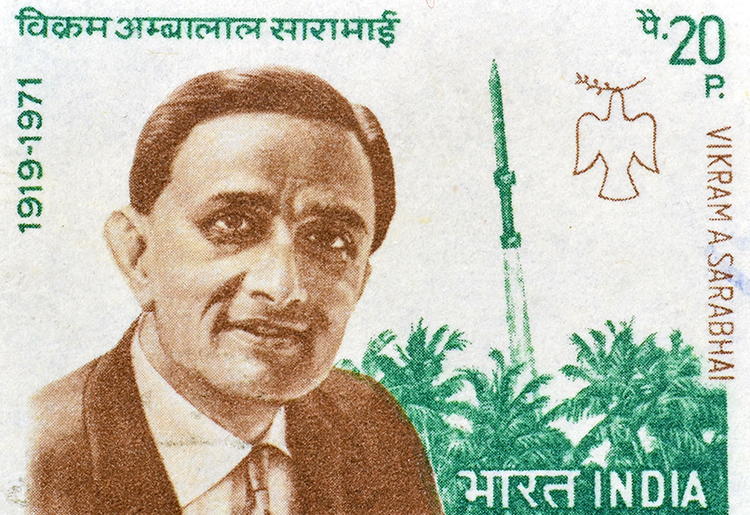
Referred to as the Father of the Indian Space Program, Vikram Sarabhai was an astronomer and physicist who pioneered India’s space research.
Not only a renowned scientist, Sarabhai was an industrialist, an institution builder, a social reformer and visionary whose fierce commitment to Indian independence fuelled his work to sky-rocket India into the 20th century.
From India to England, the stars and beyond, here’s the story of Vikram Sarabhai.
An industrious beginning
Vikram Ambalal Sarabhai was born on 12 August 1919 into the well-known Sarabhai family. The Sarabhai’s were major industrialists committed to securing India’s independence from British colonial rule , encouraging Vikram to study science at Gujarat College in Ahmedabad.
Sarabhai’s study then took him to the University of Cambridge in England, where he sat his final exams in natural sciences in 1940. By this time, war had engulfed Europe, Britain and its colonies, including India. Sarabhai returned to his homeland where he began researching cosmic rays.
With the end of war in 1945, Sarabhai returned to Cambridge to complete a doctorate, writing the thesis ‘Cosmic Ray Investigations in Tropical Latitudes’ in 1947.
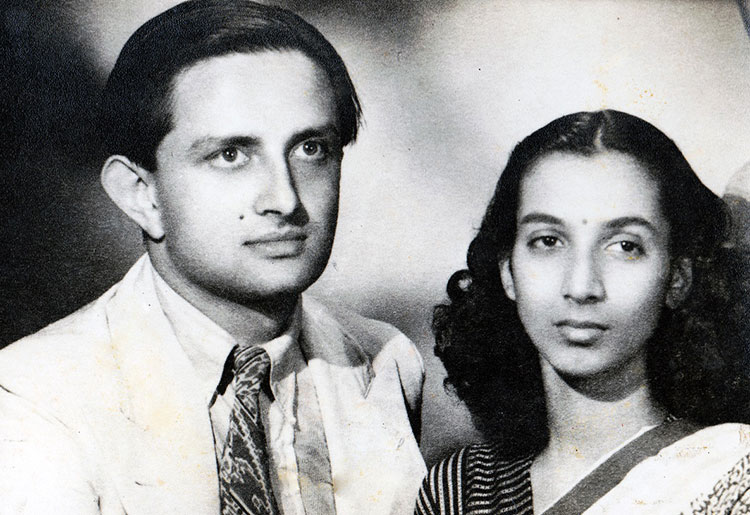
Vikram and Mrinalini Sarabhai (1948)
Image Credit: Jigneshnat, Public domain, via Wikimedia Commons
Father of the Indian Space Program
Back in India again, Sarabhai founded the Physical Research Laboratory in Ahmedabad. The lab came to be known as the ‘cradle of space sciences’ in India, and initially focused its research on cosmic rays and the upper atmosphere. This research soon expanded to include theoretical and radio physics, funded by the Atomic Energy Commission.
He established the Indian National Committee for Space Research in 1962 (renamed the Indian Space Research Organisation or ISRO), as well as the Thumba Equatorial Rocket Launching Station. Both institutions remain in operation today.
What else should Sarabhai be remembered for?
Sarabhai’s interests were not limited to space. He was committed to developing industry, business and other socio-economic issues India faced.
Alongside managing his family’s business group, Sarabhai founded numerous non-profit organisations such as the Ahmedabad Textile Industry’s Research Association, which he managed between 1947 and 1956. From this experience, he saw the need for professional management education in India.
Under British colonial rule , management positions had commonly been assumed by British colonists. Sarabhai therefore played a large role in setting up the Indian Institute of Management in Ahmedabad in 1962.
Sarabhai had married Mrinalini Sarabhai, a classical Indian dancer from a prominent family committed to Indian independence in 1940. Despite a troublesome marriage, together they founded the Darpana Academy of Performing Arts to promote traditional Indian crafts culture in Ahmedabad.
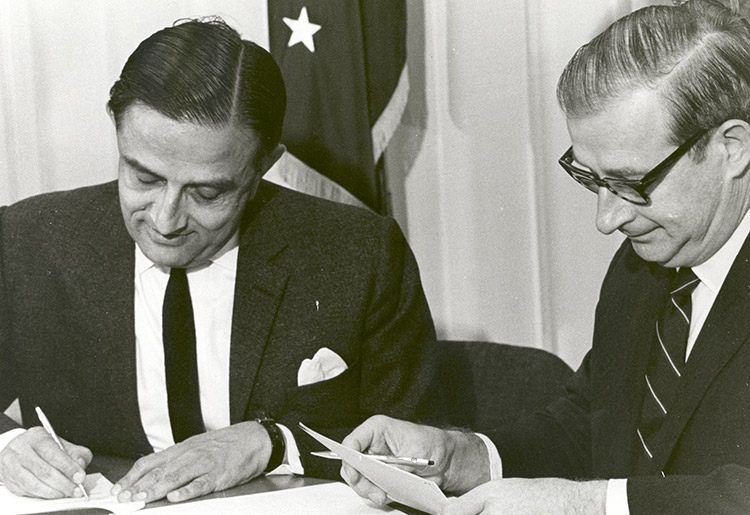
Dr. Vikram A. Sarabhai, (left) and Dr. Thomas O. Paine, NASA Administrator
Image Credit: NASA, Public domain, via Wikimedia Commons
After the death of India’s leading physicist Homi Bhabha in 1966, Sarabhai was appointed chairman of the Atomic Energy Commission of India. He avidly continued Bhabha’s work in nuclear research, establishing India’s nuclear power plants and even taking the first steps towards India’s development of nuclear defence technology in the uncertain Cold War climate.
He devised programs to take education to remote villages using satellite communication and called for satellites to be used in searching for natural resources.
Ultimately, Sarabhai passionately believed all aspects of science and technology, especially anything related to space , were “levers of development”. Through science, Sarabhai would propel a decolonising India into a new age.
What was Vikram Sarabhai’s legacy?
One evening in December 1971, Sarabhai was reviewing a design while getting ready to head to Bombay that night. After a brief conversation with fellow space researcher Avul Pakir Jainulabdeen Abdul Kalam (who would later be President of India), Sarabhai died of a heart attack aged 52.
For his service to independent India, Sarabhai was awarded two of the country’s highest honours: the Padma Bhushan in 1966, and the Padma Vibhushan, awarded posthumously in 1972.
His contribution to science has been recognised in the years since his death in a variety of ways: one of the Indian Space Research Organisations buildings was named after him; the Vikram Sarabhai Journalism award was created in his name; and the Indian Postal Department released a commemorative stamp on the first anniversary of his death.
Undoubtedly, Sarabhai’s legacy remains the huge leaps made by Indian space and nuclear science in the years following independence, earning India a place among the world’s leading space-faring countries and Sarabhai international renown as Father of the Indian Space Program.
You May Also Like
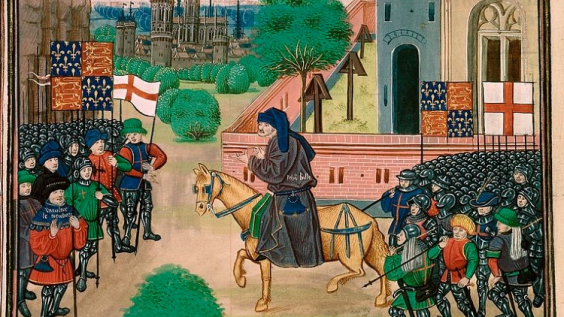
The Peasants’ Revolt: Rise of the Rebels
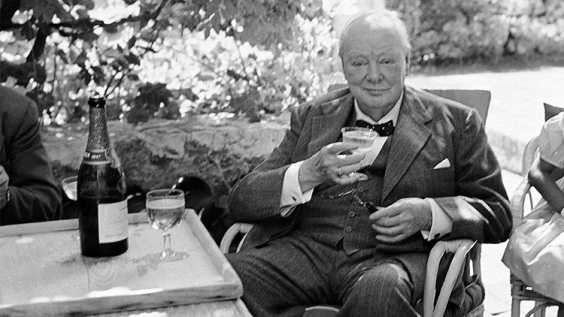
10 Myths About Winston Churchill
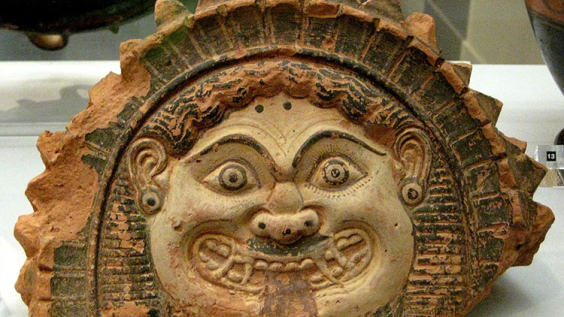
Medusa: What Was a Gorgon?
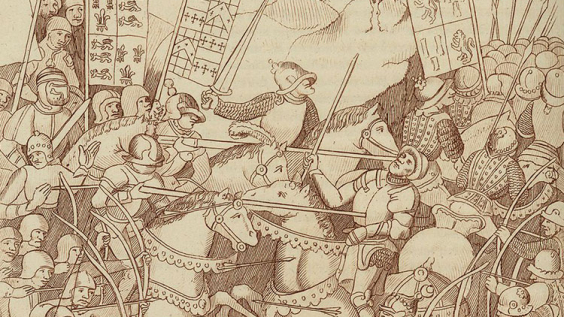
10 Facts About the Battle of Shrewsbury
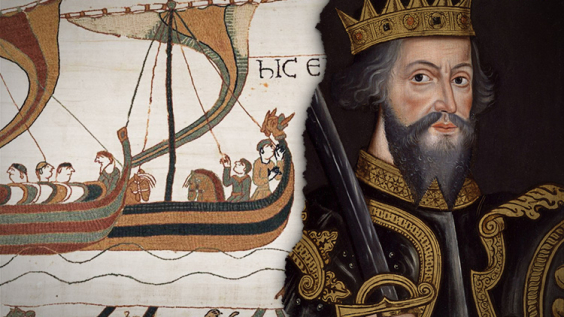
5 of Our Top Podcasts About the Norman Conquest of 1066
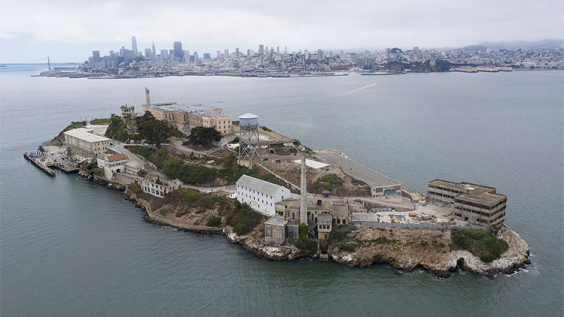
How Did 3 People Seemingly Escape From Alcatraz?
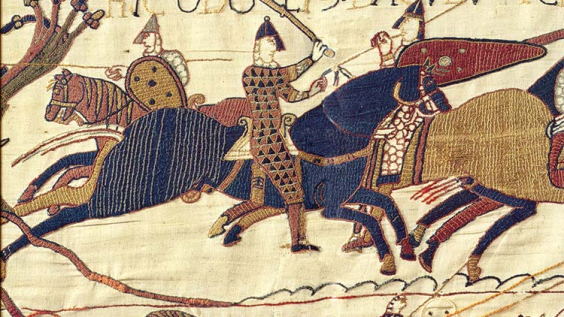
5 of Our Top Documentaries About the Norman Conquest of 1066
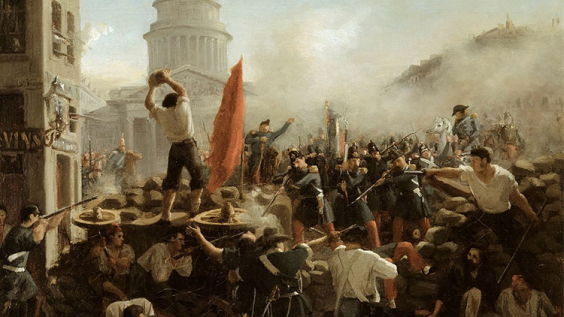
1848: The Year of Revolutions
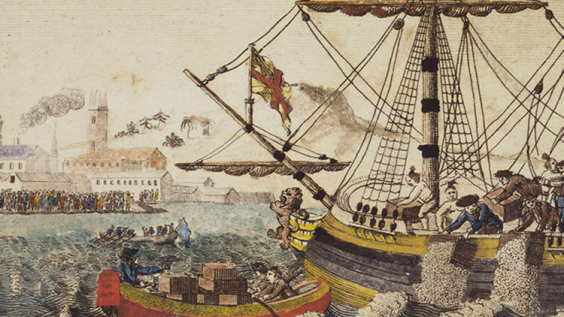
What Prompted the Boston Tea Party?
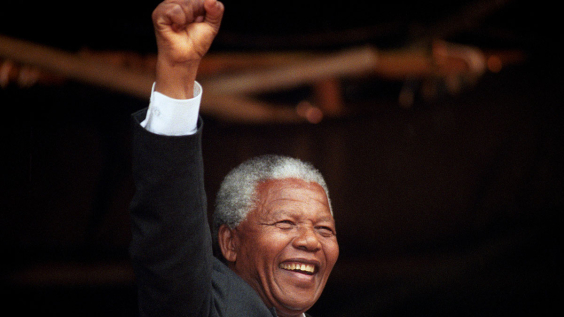
15 Quotes by Nelson Mandela

The History of Advent

The Princes in the Tower: Solving History’s Greatest Cold Case
- India Today
- Business Today
- Reader’s Digest
- Harper's Bazaar
- Brides Today
- Cosmopolitan
- Aaj Tak Campus
- India Today Hindi
Get 72% off on an annual Print +Digital subscription of India Today Magazine
From the archives (2008) | vikram sarabhai: the man who initiated india’s space programme, remembering vikram sarabhai, one of india’s most dynamic and endearing visionaries who headed the country’s nuclear mission in the ’60s, on his birthday (august 12).
Listen to Story

It is an odd bit of daredevilry to associate with a man credited with writing 80-odd scientific papers, setting up almost 40 institutions, initiating India’s space programme and heading its nuclear energy programme in the ’60s. On the other hand, in that boyhood act of heroism one can probably find the key, the essential mix of daring, skill and audacity that made his life extraordinary.
The seeds of this remarkable life were probably sown in early childhood and fostered by his unusual upbringing. Sarabhai came from a prosperous Jain family of textile mill owners in Ahmedabad. The Sarabhais, in addition to being wealthy, were close to Mahatma Gandhi and were known for their strong sense of social responsibility: Vikram’s aunt, Ansuya, founded the city’s first trade union of textile workers and his sister Mridula was actively involved in the freedom movement and went to jail many times.
Vikram and his seven siblings were educated in a private experimental school on the family’s 21-acre property, an education that included a range of extra-curricular activities as well as an exposure to distinguished visitors such as Rabindranath Tagore, Jawaharlal Nehru and Rukmini Devi Arundale. He went on to pursue physics at the Indian Institute of Science in Bangalore—where he studied under Nobel laureate C.V. Raman and struck a friendship with Homi Bhabha, who later set up India’s atomic energy programme—and later at Cambridge.
In the fervently idealistic post-Independence era, Sarabhai established several institutions such as the Physical Research Laboratory; the Darpana Dance Academy, which he co-founded with his wife, Mrinalini; the Ahmedabad Textile Industry’s Research Association (ATIRA), India’s first textile research cooperative; the country’s first market research agency, the Operations Research Group; the Indian Institute of Management (Ahmedabad) and helped in setting up the National Institute of Design. The range of activities reveals the astonishing diversity of his interests and also the consistency of his approach which involved the use of scientific methods, sound financial plan and a clear nationalistic purpose.
All these features were evident in his conceptualisation of the space programme. In the early ’60s when space technology was being used for military purposes and one-upmanship between the superpowers, the idea of a poor struggling nation aspiring to a space programme of its own seemed a fairly unthinkable one. Sarabhai made it seem not only feasible but essential by setting targets for the development of technology and mapping out a range of applications—communications, weather forecasting and mineral prospecting—that could answer the needs of a developing nation.
All his projects, whether it was the satellite instructional television experiment which in 1975-76 used a NASA satellite to beam educational content to 2,400 of India’s poorest villages, or his plan for building agricultural complexes serviced by atomic power and desalinated sea water, were fired with an imaginative zeal. He worked 18-20 hours every day using both charm and persuasion to convince others, including his seniors like Bhabha, and industrialist Kasturbhai Lalbhai, who collaborated in many of his ventures, and his subordinates to share his dreams. He did have his share of critics. There were some who found his ideas wildly impractical. And others who did not appreciate his complex and highly nuanced approach to the sensitive issue of nuclear weapons. It is hard to dispute though, that when he passed away, on December 30, 1971, at the age of 52, India lost one of her most dynamic and endearing visionaries.
—The author has written Sarabhai’s biography, Vikram Sarabhai: A Life
QUICK TAKES
Q: Under which scholar did Vikram Sarabhai do research on cosmic rays? A: C.V. Raman
Q: Which was one of the first institutions he formed? A: The Physical Research Laboratory in Ahmedabad in 1947
Q: Where did he set up the first rocket launching station? A: At Thumba near Thiruvananthapuram
Q: When was he appointed chairman of the Atomic Energy Commission? A: In May 1966
Q: Where did he receive his early education? A: In Retreat, an experimental school run by his parents in Ahmedabad
(The article was published in the INDIA TODAY edition dated April 21, 2008)
Subscribe to India Today Magazine
- Skip To Main Content
- Skip To Navigation
- Screen Reader Access

Search form

- COVID-19 Research
- Agricultural Sciences
- Astronomy & Space Sciences
- Chemical Sciences
- Cognitive Sciences and Psychology
- Computer Sciences and IT
- Earth, Atmosphere & Environment Sciences
- Energy Sciences
- Engineering Sciences
- Life Sciences & Biotechnology
- Mathematical Sciences
- Material Sciences
- Medical Sciences
- Pharmaceutical Sciences
- Physical Sciences
- Traditional Knowledge
- Other Areas
- Institutional
- International
- Grants for Seminar and Conferences
- Startup Grants
- Ministries & Departments
- Centres of Excellence
- Thematic Centres
- Centres of Higher Learning
- National Academies
- Statewise S&T Organisations
- Industry Related Associations
- Laboratories
- International Organisations
- Civil Societies
- Science Centres & Planetaria
- All Programmes & Schemes
- Research and Development
- Human Resource and Development
- Women Schemes
- International Programmes
- Societal Development
- Academia Industry Partnerships
- School Students
- Graduate Students
- Post Graduate Students
- PhD Scholars
- Post Doctoral Fellowships
- Scholarships for Women
- Faculty and Scientists
- National Fellows
- COVID-19 Technology
- Earth, Atmosphere & Env. Sciences
- Rural Technologies
Featured Science
Remembering vikram sarabhai: the father of indian space programme.
India’s achievement in the field of space science makes one inevitably think of one extraordinary figure —Vikram Ambalal Sarabhai — popularly called Vikram Sarabhai and widely known as ‘father of Indian space programme’, the man who placed India on the international map in the field of space research. Had it not been the Sarabhai’s vision and pioneering contribution, India would not have achieved the heights it did in the field of space science.
Born on August 12, 1919 in Gujarat’s Ahmedabad in a wealthy Jain business family his father Ambalal Sarabhai was a renowned businessman and owned many mills in Gujarat. Being a physicist and an astronomer he initiated space research and helped develop nuclear power in India. He was considered the Father of the Indian space program. Being a great institution builder, he helped establish many institutions in diverse fields.
He was a creative genius, a successful and forward looking industrialists, an innovator and a great institution builder. Establishment of India Space Research Organisation (ISRO) was one of his greatest achievements as he was the person who convinced the Government about the significance of a space programme for a developing country like India.
However, the most important thing is that besides being all that he was a very warm human being with tremendous compassion for others. He was a man who could charm and win the hearts of all those who came in contact with him. He could instantly establish a personal rapport with those with whom he interacted. This was possible because he could convey a sense of respect and trustfulness to them and also a sense of his own trustworthiness.
He had an uncanny ability to gauge the capability of a person just by talking to him for a few minutes. In fact he used to frequently say that he could judge a person from the sparkle in his/her eyes. He believed in systematically developing people. At times he will go out of the way to give a person full opportunity of developing himself/herself. He had a pleasant personality. It is said that by his mere smile he was able to transmit a great deal of inspiration to all those who worked with him.
After completing his Intermediate Science examination from Gujrat College, he shifted to Cambridge, UK in 1937 where he obtained his Tripos in Natural Sciences in 1940. At the outbreak of the Second World War he returned to India and joined the Indian Institute of Science at Bangalore where he took up research in cosmic rays under the supervision of C.V. Raman. He published his first research paper entitled “Time Distribution of Cosmic Rays” in the Proceedings of Indian Academy of Sciences.
Sarabhai’s work on cosmic rays during the period 1940-45 included the study of the time variations of cosmic rays with Geiger-Muller counters at Bangalore and at the high level station in the Kashmir Himalayas. After the war he returned to Cambridge to work for his PhD is cosmic ray physics. In 1947, he was awarded PhD by the Cambridge University for his thesis ‘Cosmic Ray investigation in Tropical Latitudes’.
After he returned from Cambridge to an independent India in 1947, he persuaded charitable trusts controlled by his family and friends to endow a research institution near his Ahmedabad home. He founded the Physical Research Laboratory (PRL) in Ahmedabad on November 11, 1947, at the age of just 28.
After the death Homi J Bhabha in January 1966, Sarabhai was asked to assume the responsibilities of the office of the Chairman, Atomic Energy Commission. At that time he was deeply involved in three major areas. In his own words (what he wrote to the Prime Minister accepting the offer):
“Currently I have substantive responsibilities in three areas. Firstly, at the Physical Research Laboratory as Director and Professor of Cosmic Ray Physics, where I continue my research and the supervision of doctoral candidates. Second, as Chairman of the Indian National Committee for Space Research Programme as well as the project for the development of rockets and space technology. Thirdly, I have been concerned with policy making, operations, research planning and evaluation of a significant segment of the family business interests, particularly centered around chemicals and pharmaceuticals”. He had also regular association with the Laboratory of Nuclear Science of the Massachusetts Institute of Technology, USA. But all these did not deter Sarabhai from assuming the new responsibility in the interest of the country. He had to disassociate himself from the family business. He was at the helm of both atomic energy and space research programmes in India from May 1996 till his death.
Sarabhai had realised the enormous potentialities inherent in space science and technology for a wide range of social and economic development activities – communication, meterology/weather forecasting, and exploration for natural resources, to name only a few. The Physical Research Laboratory, Ahmedabad, established by Sarabhai pioneered research in space sciences and subsequently in space technology. Sarabhai also spearheaded the country’s rocket technology. He played a pioneering role in the development of satellite TV broadcasting in India.
Sarabhai was also a pioneer of the pharmaceutical industry in India. He was among the very few in the pharmaceutical industy who recognised that the highest standards of quality should be established and maintained at any cost. It was Sarabhai who first implemented Electronic Data Processing and Operations Research Techniques in the pharmaceutical industry. He played an important role in making India’s pharmaceutical industry self-reliant and self-manufacture of many drugs and equipment in the country.
Sarabhai died on 30 December 1971 at Kovalam, Thiruvananthapuram, Kerala. In 1974, the International Astronomical Union at Sydney decided that a Moon Crater BESSEL in the Sea of Serenity will be known as the Sarabhai Crater. His body was cremated in Ahmedabad. He was honoured with Padma Bhushan in 1966 and the Padma Vibhushan (posthumously) in 1972.
The various institutions established and looked after by Sarabhai benefitted from each other’s experience and techniques to their mutual advantage. Some of the most well-known institutions established by Sarabhai are:-
Physical Research Laboratory (PRL), Ahmedabad
Indian Institute of Management (IIM), Ahmedabad
Community Science Centre, Ahmedabad
Darpan Academy for Performing Arts, Ahmedabad
Vikram Sarabhai Space Centre, Thiruvananthapuram
Space Applications Centre, Ahmedabad (This institution came into existence after merging six institutions/centres established by Sarabhai)
Faster Breeder Test Reactor (FBTR), Kalpakkam
Variable Energy Cyclotron Project, Calcutta
Electronics Corporation of India Limited (ECIL), Hyderabad
Uranium Corporation of India Limited (UCIL), Jaduguda, Bihar
- Bihar Board
SRM University
Ap inter results.
- AP Board Results 2024
- UP Board Result 2024
- CBSE Board Result 2024
- MP Board Result 2024
- Rajasthan Board Result 2024
- Shiv Khera Special
- Education News
- Web Stories
- Current Affairs
- नए भारत का नया उत्तर प्रदेश
- School & Boards
- College Admission
- Govt Jobs Alert & Prep
- GK & Aptitude
- general knowledge
Vikram Sarabhai: All you need to know about Indian physicist, scientist, industrialist and an astronomer on his 101 anniversary
Vikram Ambalal Sarabhai was an Indian physicist, scientist, industrialist and an astronomer who helped in developing nuclear power in India. He also initiated the space research in the country. Today is the 101 birth anniversary of Vikram Sarabhai.

Vikram Sarabhai: Birth, Early Life, Education
Vikram sarabhai: career .
In 1947, PRL (Physical Research Laboratory) was founded by Vikram Sarabhai to research on cosmic rays. On November 11, 1947, the institute was formally established at M.G. Science Institute, Ahmedabad with the help from the Karmkshetra Educational Foundation. Kalpathi Ramakrishna Ramanathan, the Professor of Ahmedabad Education Society became the first Director of the Institute.
Vikram Sarabhai led his family business and set up the Operations Research Group (ORG). This was the first research organization in the country. He also set up various institutes such as the Nehru Foundation for Development in Ahmedabad, the Indian Institute of Management Ahmedabad (IIMA), the Ahmedabad Textile Industry's Research Association (ATIRA) and the (CEPT).
Vikram Sarabhai: Personal Life
Vikram sarabhai: death, vikram sarabhai: positions held.
1- In the year 1962, he served as the President of the Physics section in Indian Science Congress.
2- In 1970, he held the position of President of the General Conference of the I.A.E.A., Vienna.
3- During 1966-1971, Vikram Sarabhai served as the Chairman of the Atomic Energy Commission of India.
4- In 1971, he served as the Vice-President in the Fourth UN Conference on 'Peaceful uses of Atomic Energy'.
Vikram Sarabhai: Legacy
1- The Vikram Sarabhai Space Centre (VSSC) is named after him. It is India's leading Space Research Organization for vehicle development in Kerala.
2- Vikram Sarabhai along with other industrialists played a major role in setting up the Indian Institute of Management (IIM), Ahmedabad.
3- On December 30, 1972, on his first death anniversary, a commemorative Postal Stamp was released by Indian Postal Department.
4- A lunar crater in the Sea of Serenity is named after him as Sarabhai Crater by International Astronomical Union in the year 1973.
5- On September 20, 2019, Chandrayaan-2, the lander on India's moon mission is named after him.
6- Vikram A Sarabhai Community Science Centre (VASCSC) is named after him and is located in Ahmedabad, Gujarat.
Vikram Sarabhai: Interesting Facts
1- Once Vikram Sarabhai said, 'I pay more than Rs 4 crore in taxes, you can assume that my money, paid as tax, is being used for the space programme'. This statement came after a professor asked Sarabhai that why he was spending taxpayers money on space science, which was barely known in India.
2- He was famously known as the 'Cradle of Space Sciences' in India.
3- Former ISRO Chairman, DR Kasturirangan in his address fondly recalled his interaction with the ISRO founder, Vikram Sarabhai. Kasturirangan was interviewed by Vikram Sarabhai himself for a job at PRL and his journey from PRL to ISRO. He stated, 'Dr Sarabhai had a way of testing people’s resolve by asking specific questions and not glossing over the subject. After he understood the candidate, he would spell out his vision and explain his ideas. He would make even those who are very junior to him feel at ease by establishing a personal connect'.
Vikram Sarabhai: Awards
1- In the year 1966, Vikram Sarabhai was honoured with Padma Bhushan-- India's third-highest civilian award.
2- In the year 1972, he was honoured posthumously with Padma Vibhushan-- India's second-highest civilian award.
Get here current GK and GK quiz questions in English and Hindi for India , World, Sports and Competitive exam preparation. Download the Jagran Josh Current Affairs App .
- IPL Schedule 2024
- Highest Score in IPL
- Fastest 50 in IPL
- DC vs KKR Head to Head
- IPL 2024 Points Table
- Lok Sabha Election Date 2024
- IPL Channel Number List 2024
- April Important Days 2024
- Maya Angelou Quotes
- International Fact Checking Day
Latest Education News
TSPSC Accountant Result 2024 Out at websitenew.tspsc.gov.in: Download DV schedule
CCS University Result 2024 2024 Out: चौधरी चरण सिंह यूनिवर्सिटी रिजल्ट ccsuniversity.ac.in पर जारी, यहां से डाउनलोड करें मार्कशीट
NEET Chemistry Deleted Syllabus 2024: Check Chapters and Topics Removed From Syllabus
OPSC Veterinary Assistant Surgeon Salary 2024: Pay Scale, Allowances & Job Profile
भारत के तीन सबसे अधिक जिले वाले राज्य कौन-से हैं, जानें
KCET Admit Card 2024 Out, Download At cetonline.karnataka.gov.in
उत्तर प्रदेश के 10 सबसे बड़े जिले कौन-से हैं, जानें
JEE Main 2024 Session 2 Exam Begins Today, Check NTA Exam Day Instructions, Things Allowed in Exam Hall
JEE Main 2024 Session 2 Admit Card Out For Exams From April 8 to 12, Exams Begin Today
International Carrot Day 2024: Date, History, Significance, Facts & More
AIASL Executive Recruitment 2024: Apply Online For 247 Handyman and other posts, Check walk-in schedule
Today’s IPL Match (4 April) - GT vs PBKS: Team Squad, Match Time, Where to Watch Live and Stadium
What exactly is the Havana syndrome?
Who Won Yesterday IPL Match: DC vs KKR, Match 16, Check All Details and Latest Points Table
Jagran Josh Education Awards 2024: Educational Leaders, Teachers, Students honoured for their Remarkable Innovations to Solve Real-world Problems
Highest Team Scores of All Time in IPL (2008 - 2024): Most Runs in an Innings Totals
Optical Illusion IQ Test: Only 1% High IQ Genius Can Find The COACHMAN Hidden In This 18th Century Picture. 13 Seconds Left!
Picture Puzzle IQ Test: You Are Highly Attentive If You Can Spot The Pencil In 12 Seconds!
SSC GD Answer Key 2024 OUT: Direct Link Active, Download Constable Response Sheet PDF on ssc.gov.in
SSC GD Constable Answer Key 2024 Out: Link Active on ssc.gov.in

Vikram Sarabhai Biography – Early Life, Achievements, Contributions to Indian Space Program
Read here in detail about Vikram Sarabhai Biography . Also know about his Early Life, Achievements, Contributions to Indian Space Program.

Table of Contents
Vikram Sarabhai, a renowned scientist, made a lasting impact on India’s scientific scene by spearheading space research. Known as the “Father of the Indian Space Program,” his valuable contributions have instilled a deep appreciation for science and the scientific community among Indians. Sarabhai’s life was a mix of a strong love for science and a lasting interest in diverse fields like dance, theatre, and music. His exceptional intellect distinguished him as one of the country’s most remarkable scientific minds. He played a crucial role in leading the Atomic Energy Commission (AEC) and the Indian Space Research Organisation (ISRO), two of India’s top scientific institutions. This information is useful for those preparing for the UPSC Exam’s Science & Technology section, offering insights into India’s space research and Vikram Sarabhai’s outstanding contributions.
The Early Years of Vikram Sarabhai
- family, known for their involvement in industry and active participation in the Indian Independence movement.
- His parents, Ambalal Sarabhai and Sarladevi Sarabhai, created a cultured and enlightened environment at home, emphasizing the importance of education.
- The Sarabhai household served as a gathering place for various notable individuals, including political leaders, freedom fighters, and social workers. Guests included Mahatma Gandhi, Rabindranath Tagore, J. Krishnamoorthy, Motilal Nehru, Jawaharlal Nehru, Maulana Azad, Sarojini Naidu, Srinivasa Sastri, and C.F Andrews.
- Despite their affluent background, the Sarabhai family led a simple life, rejecting excessive luxury. Vikram’s parents instilled in their children values such as productivity, honesty, and leading a grounded life.
- Vikram’s early education followed the Montessori system, and the Sarabhai family, followers of Jainism, actively participated in the freedom movement, including Mahatma Gandhi’s Dandi march.
- Vikram’s intellectual journey commenced at the Retreat school, and after completing his Matriculation, he enrolled at Gujarat College, the first college in the state established by the British.
- Vikram’s interest in Sanskrit poetry, particularly the works of Kalidasa, such as Meghadootam and Vikramorvasiyam, became a significant aspect of his educational pursuits.
- For higher education, Vikram Sarabhai ventured to Cambridge University, supported by a letter of recommendation from Rabindranath Tagore.
- Upon completing his undergraduate studies in Physics and Chemistry, Vikram Sarabhai returned to India and joined the Indian Institute of Science (IISC).
- At IISc, he delved into research on Cosmic rays and engaged with C.V. Raman, India’s first Nobel laureate, and Homi J. Bhabha, the architect of India’s Atomic Energy Programme, both Cambridge alumni.
- In August 1942, Vikram married Mrinalini Swaminathan, the sister of Captain Lakshmi Sehgal, associated with the Indian National Army led by Subhash Chandra Bose.
- In 1943, Vikram conducted studies on Cosmic rays at high altitudes in Kashmir, later shifting his research focus to the “time variations of cosmic rays.”
- Post the conclusion of the Second World War in 1945, he returned to Cambridge and successfully earned his Ph.D. degree.
- Vikram ardently believed in India’s capacity to build, confront challenges, and solve problems using technology and science. He advocated for the replacement of outdated technologies with innovative solutions to address societal needs.
- He actively promoted the idea of individuals acquiring essential skills from foreign countries and applying that knowledge within India, emphasizing the importance of technological and scientific advancement.
Early Organisational Endeavours
- The early phase of the Indian Space Program faced challenges, marked by a period of unbridled enthusiasm for technology.
- Vikram Sarabhai, leveraging his scientific eminence and charismatic personality, dedicated himself to enhancing the scientific mindset of the nation during this time.
- Sarabhai tirelessly conducted experiments involving diverse skill combinations, novel institutional arrangements, and innovative problem-solving approaches aligned with his interests.
- He advocated for the establishment of a nuclear centre for agriculture, uniting the expertise of agricultural and nuclear scientists, supported by the resources and backing of the Indian Council of Agricultural Research.
- Sarabhai initiated a collaborative effort between All India Radio and ESCES (Experimental Satellite Communication Earth Station) to advance television as a mass communication tool and enhance food production.
- The introduction of these groundbreaking institutional structures challenged the conventional problem-solving models prevalent in India during that period.
Swastik Mill
- Employing a scientific methodology, he addressed challenges within the industry. For the oil seeds market, he conducted statistical analyses on the market prices of groundnuts and seeds, presenting the findings graphically.
- Applying research methodology to scrutinize data and marketing activities proved fruitful, playing a pivotal role in fortifying the organization.
- Utilizing human relations techniques, he effectively resolved conflicts between employees and management, fostering a harmonious work environment.
Sarabhai Chemicals
- In the pharmaceutical landscape dominated by industry giants such as Ranbaxy, Cipla, Cadila, Glaxo, and Pfizer, Vikram initiated the establishment of Sarabhai Chemicals, a venture characterized by professional management.
- Engaging in a collaborative effort with J.R. Geigy, the producer of the whitening agent ‘Tinopol,’ proved to be a lucrative move, resulting in significant profits in the market.
- Sarabhai Chemicals further expanded its horizons by entering into a partnership with a German company, venturing into the manufacturing of Vitamin C
Indian Institute of Management Ahmedabad
- Recognizing a deficiency in effective management and skills within Indian industries, Vikram Sarabhai identified it as a significant factor contributing to the decline of both the public and private sectors. In 1956, in collaboration with Kasturbhai Lalbhai, he founded the Ahmedabad Management Association (AMA) to conduct research and provide training for organizational employees. This initiative later evolved into the esteemed Indian Institute of Management (IIM) in 1962.
- To elevate the stature of the institution, Vikram forged a strategic collaboration with the renowned Cambridge University. Despite challenges from the Ford Foundation, which pursued a similar trajectory, Vikram successfully established this premier management institute. As his focus shifted towards space research, he entrusted the directorship of IIM-A to Ravi Mathai. Subsequently, Vikram assumed the role of Chairman at Homi J. Bhabha’s Atomic Energy Commission (AEC).
- By 1957, Vikram had integrated into the international scientific community, forming connections with eminent scientists such as Bruno Rossi, James Van Allen, and others.
Father of Space Program of India
- The initiation of India’s Space Age can be traced back to the collaboration of two influential figures who envisioned leveraging science and technology as instrumental tools for national progress. In the post-independence era, Jawaharlal Nehru, a staunch advocate of the belief that science and technology could effectively address societal and economic challenges, supported their individual pursuits in the field of science.
- Nehru emphasized the significance of the space program with his statement, “There are some who question the relevance of space activities in a developing nation. To us, there is no ambiguity of purpose. We do not harbour the fantasy of competing with economically advanced nations in the exploration of the moon or the planets or manned space flight.”
Physical Research Laboratory (PRL)
- Established on November 11, 1947, by Vikram Sarabhai, the Physical Research Laboratory (PRL) serves as a National Research Institute dedicated to Space and Allied Sciences. Supported by the Government of India’s Department of Space and Allied Sciences, PRL engages in various research programs spanning Astronomy and Astrophysics, Atmospheric Sciences and Aeronomy, Earth Sciences, Solar System studies, and Theoretical Physics.
- Situated in Ahmedabad, PRL actively conducts the PLANEX (Planet Research and Exploration Program). The institute acknowledges outstanding contributions to the realm of science and technology by presenting the ‘Hari Om Ashram Prerit Vikram Sarabhai Research Award’ and the ‘PRL Award’ to deserving scientists.
Indian National Satellite System (INSAT)
- During the Bombay National Electronics Conference in 1970, Vikram Sarabhai revealed intentions to launch an Indian National Satellite. The Indian Space Research Organisation (ISRO) subsequently deployed these versatile geostationary satellites to enhance telecommunication, meteorological services, and broadcasting.
- Sarabhai’s INSAT project resembled a direct-broadcast satellite designed to provide educational content to rural communities through television. Commissioned in 1983 as a collaborative effort involving the Department of Space, Department of Telecommunications, India Meteorological Department, All India Radio, and Doordarshan, it emerged as the largest domestic satellite communication system in the Asia-Pacific region.
INCOSPAR ( Indian National Committee for Space Research )
- In response to the launch of Sputnik-1 by Russia in 1957, the International Council for Science established the Committee on Space Research, known as COSPAR, in 1958. In India, Homi J. Bhabha, entrusted with overseeing research for the Department of Atomic Research (DAE), initiated the creation of an Indian counterpart to COSPAR named INCOSPAR, appointing Vikram Sarabhai as its Chairman.
- Under Mr. Sarabhai’s leadership, a six-day seminar on Space Science was organized at the Physical Research Laboratory (PRL) in Ahmedabad.
- By the early 1960s, India’s collaboration with the Soviet Union played a pivotal role in advancing Space Research through the establishment of the Indian Space Research Organisation (ISRO). This partnership also contributed to the growth of nuclear power in India, even after the Nuclear Bomb test in Pokhran, Rajasthan.
- Following the demise of Homi Bhabha in 1966, Vikram Sarabhai assumed the role of Chairman of the Atomic Energy Commission and Secretary of the Department of Atomic Energy (DAE). In the 1960s, they jointly established four key institutions. – Space Science and Technology Centre (SSTC) – Experimental Satellite Communication Earth Station (ESCES, established in 1967) – Sriharikota Base (Originally known as Sriharikota High Altitude Range, SHAR, now rebranded as Satish Dhawan Space Centre, SDSC) – Indian Satellite System Project (ISSP)
- In 1969, Vikram Sarabhai orchestrated the restructuring of ISRO, assuming oversight of all of India’s space activities. His brainchild, the Physical Research Laboratory (PRL), played a pivotal role in conducting fundamental research spanning aeronomy, cosmic rays, interplanetary space, and solar activity. The Tata Institute of Fundamental Research (TIFR) served as the inception point for India’s Atomic Energy Program.
- A collaborative sounding rocket program was initiated with NASA (U.S.), CNES (France), and the Hydrometeorological Services (USSR). The Bhabha Atomic Research Centre (BARC), formerly under the Department of Atomic Energy (DAE), took charge of local rocket manufacturing.
- The establishment of the Space Science and Technology Centre (SSTC) aimed at developing advanced sounding rockets, a modest satellite launcher, and expertise in aerospace engineering.
Indian Space Research Organisation (ISRO)
- Indian Space Research Organisation (ISRO) founded in 1969 by Vikram Sarabhai
- Vision focused on the development of new launch vehicles
- Successful Sounding Rocket Program in the 1960s
- Launch of Satellite Launch Vehicle-3 (SLV–3) and Augmented Satellite Launch Vehicle (ASLV)
- Further development of Polar Satellite Launch Vehicle (PSLV) and Geosynchronous Satellite Launch Vehicle (GSLV)
- Headquarters located in Antariksh Bhavan, Bangalore
- Brought under the Department of Space in 1972
Satellite Launch Vehicle (SLV)
- SLV, a four-stage solid fuel light launcher, designed by Vikram Sarabhai
- Intended to carry a payload of 40 kg and reach a height of 500m
- Maiden launch occurred in 1979, realizing Sarabhai’s vision
- Concluded its operational service after the final launch in 1983
- Decommissioning of SLV opened avenues for the development of more sophisticated versions in subsequent years.
Augmented Satellite Launch Vehicle (ASLV)
- ASLV, a five-stage solid propellant launcher, designed to accommodate a 150 kg satellite
- Developed by ISRO in the late 1980s to place payloads in Geostationary Transfer Orbits
- The initial launch test was conducted in 1987, followed by three more in 1988, 1992, and 1994
- Two of the launches proved successful
- Despite its achievements, ASLV was decommissioned at a later stage.
Polar Satellite Launch Vehicle (PSLV)
- The introduction of PSLV marked India’s capability to deploy Indian Remote Sensing satellites into sun-synchronous orbits, a technology previously exclusive to Russia.
- PSLV possesses the capacity to launch small satellites into the Geostationary Transfer Orbit (GTO).
- Over the years, PSLV has achieved success in launching nearly 30 satellites, showcasing India’s growing proficiency in space technology.
Geosynchronous Satellite Launch Vehicle ( GSLV)
- GSLV, introduced by India, is designed to launch Indian National Satellite Systems (INSAT) into Geostationary Transfer Orbit, aiming to reduce dependence on foreign rockets.
- As ISRO’s heaviest rocket launch vehicle, GSLV can carry a total payload of up to 5 tons into low earth orbit.
- After assuming the position of Chairman of the Atomic Energy Commission, Vikram Sarabhai proposed the Agro-Industrial Complex model to enhance
- India’s energy program, with support from MS Swaminathan, the pioneer of the Green Revolution in India.
- Active participation in the 14th General Conference of the International Atomic Energy Agency in Vienna showcased Sarabhai’s global involvement.
- He played a crucial role in advancing indigenous nuclear technology for defence, initiating projects such as the Fast Test Reactor in Kalpakkam and the Variable Energy Cyclotron project in Calcutta.
- In honour of Vikram Sarabhai, ISRO named the lander of its second moon mission, CHANDRAYAAN, as ‘Vikram.’
- The lead centre of the Indian Space Research Organisation, the Vikram Sarabhai Space Centre, is named after the visionary scientist.
- Recognizing his contributions, the Indian Astronomical Union named a lunar crater as the “Sarabhai Crater.”
- A community centre in Gujarat, named ‘Vikram A Sarabhai,’ pays tribute to his legacy.
- ISRO established the Vikram Sarabhai Journalism Award in Space Technology and Research as part of the centenary year celebrations of Dr. Vikram Sarabhai.
- The liquid-fueled rocket engine by ISRO, Vikas, is named in honor of Vikram Sarabhai.

Sharing is caring!
- Vikram Sarabhai
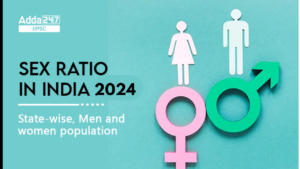
Leave a comment
Your email address will not be published. Required fields are marked *
Save my name, email, and website in this browser for the next time I comment.
BPSC Exam 2024
- BSPC 70th Notification 2024
- BPSC Syllabus and Exam Pattern
- 69th BPSC Question Paper 2023
- 69th BPSC Cut-Off
- BPSC Exam Date
- BPSC Officer Salary
- BPSC Previous Year paper
UPPSC RO ARO 2024
- UPPSC RO ARO Notification 2024
- UPPSC RO ARO Syllabus 2024
- UPPSC RO ARO eligibility 2024
- UPPSC RO ARO PYQ
- UPPSC RO ARO Salary 2024
RPSC RAS 2024
- RPSC RAS Question Paper
- RPSC RAS Exam Analysis
- RPSC RAS Cut off
- RPSC RAS Notification
- RPSC RAS Syllabus
- RPSC RAS Salary
- RPSC RAS Previous Year paper
- Madhya Pradesh Judiciary
- Punjab Judiciary
- Bihar Judiciary

- Notification
- Exam Date/Calendar
- History & Culture
- Polity & Governance
- Environment & Ecology
- Government Schemes & Initiatives
- UPSC Daily Quiz 2023
- UPSC Prelims Mock Test
- UPSC Current Affairs 2023
- Yojana Magazine
- The Hindu Editorial

IMPORTANT EXAMS
- UPSC Notification
- UPSC Syllabus
- UPSC Prelims P.Y.Q
- UPSC Final Result 2023
UPSC EPFO/APFC
- UPSC EPFO Syllabus
- UPSC EPFO Admit Card
- UPSC APFC Notification
- UPSC APFC Syllabus
- UPPSC PCS 2024
- MPPSC PCS 2024
- RPSC PCS 2024
- UKPSC PCS 2024
Our Other Websites
- Teachers Adda
- Bankers Adda
- Adda Malayalam
- Adda Punjab
- Current Affairs
- Defence Adda
- Adda Bengali
- Engineers Adda
- Adda Marathi
- Adda School

UPSC CSE Exam (Popularly called UPSC IAS Exam) is one of the toughest exam in this country. Needless to say, a dedicated and right approach is required to clear this IAS Exam.
Download Adda247 App
Follow us on
- Responsible Disclosure Program
- Cancellation & Refunds
- Terms & Conditions
- Privacy Policy
- International
- Today’s Paper
- Premium Stories
- Express Shorts
- Health & Wellness
- Board Exam Results
Remembering Vikram Sarabhai in his birth centenary year
The architect of india's space programme founded 38 institutions, many of which continue to be a critical part of the country's missions..
LAST WEEK, scientists from all corners of India descended on Ahmedabad to remember a man whom the late president, APJ Abdul Kalam, had famously termed “Mahatma Gandhi of Indian Science”. They were there to launch celebrations on the birth centenary of Vikram Sarabhai, 47 years after he was found dead in a hotel room in Kovalam in Kerala at the age of 52, by when he had founded 38 institutions that are now leaders in space research, physics, management and performing arts.
Former director of the Space Applications Centre Pramod Kale was a 19-year old science graduate from MS University of Baroda, besotted by space technology, when he first met Sarabhai. “In May 1960, I went to Ahmedabad to meet Dr Sarabhai. At the time, his office was at the Calico Mills which is where I met him and ended up talking for two hours,” Kale says.

By June that year, Kale had done exactly as Sarabhai had advised him and taken up a master’s course at Gujarat University. In 1962, when Sarabhai was looking at studying the magnetic equator, Kale went on to be among the first few to go to NASA to learn radar tracking.
The room resounded with many such memories. Former ISRO chairman K Kasturirangan remembered how they ran into some trouble at the Physical Research Laboratory (PRL), founded in 1947 by Sarabhai, in their attempts to fly a balloon at 4 am, when in sailed Sarabhai. “He told us had the flight been successful, you would not have learnt even half of what you learnt because of that initial problem,” said Kasturirangan.
Many of those who had collected in Ahmedabad in Sarabhai’s memory were teenagers when they first met him. Gandhinagar -based entrepreneur K Subramanian was 19 and a student of National Institute of Technology, Tiruchirappalli, working on a summer project at PRL, when a man in a kurta-pyjama walked in and began turning all the wastepaper bins upside down, inspecting their contents and putting them back again. “I asked a colleague who that was and was told it is Dr Vikram Sarabhai. He had come to check how much waste the lab was generating,” laughs Subramanian.

Born to Ambalal and Sarla Devi, Ahmedabad’s leading textile-mill owners, Vikram Sarabhai showed creative promise early. He was 15 when he built a working model of a train engine with the help of two engineers, which is now housed at the Community Science Centre (CSC) in Ahmedabad. The CSC was Vikram’s way of providing other children the privileges he had, of experimental research, says his son Kartikeya, 71, adding how his father wished to work with children at the science centre after he retired.
“He was essentially a researcher, and believed that people, especially children, should be allowed to think freely and come up with solutions on their own,” recalls Kartikeya, who founded the Centre for Environment Education in 1984. His sister and Indian classical dancer Mallika recalls how, as children, they were at the centre of every family decision. This freedom helped “garner convictions early in life and to take a position. You were never too young to be able to be involved in what was going on or what affected you,” says Mallika, 65. Kartikeya is carefully piecing together all the dog-eared notes he is discovering in the recesses of their three grand homes — Shanti Sadan, The Retreat and Chidambaram.
To inspire the young to dream like Sarabhai, Kartikeya is building a permanent exhibition gallery on the Sabarmati Riverfront, expected to open this November, while Mallika is in talks with ISRO and is designing a performance to attract the young to careers in science. Their father would have approved. After studying from Gujarat University in Ahmedabad, Sarabhai went to study physics and mathematics at Cambridge University, with a reference from Rabindranath Tagore, but was forced to return when World War II broke out. He completed his post-graduation at the Indian Institute of Science in Bengaluru under Dr CV Raman, where he also met Dr Homi Bhabha, and returned later to Cambridge for a PhD in cosmic rays. When Sarabhai and Indian classical dancer Mrinalini Swaminathan married in 1942, the Quit India movement had broken out and his eldest sister Mridula had been arrested. None of the family could attend the wedding except Vikram’s driver, Lala, recalls Kartikeya.

The PRL, ISRO’s predecessor, the Indian National Committee for Space Research as well as the Space Applications Centre in Ahmedabad are the cradle of India’s space programme, and continue to be a critical part of the country’s missions. Sarabhai’s research-and applications-based approach singled him out as a scientist and entrepreneur who lived ahead of his time. Those who worked closely with Sarabhai say he was quick to recognise people’s capabilities, which made him an exceptional manager. In 1963, NASA was keen on only PhD fellows to impart its technical know-how to. “NASA reasoned that they wanted only people who spoke English and, thus, insisted on PhD as the minimum requirement, but Dr Sarabhai managed to assure them that Indians spoke English without a PhD as well,” says Kale.
Padmanabh Joshi who works with the Nehru Foundation for Development remembers his first meeting meeting with him when he was 17 and working on a socio- economic survey commissioned by Sarabhai. Joshi had asked him the connection between atomic energy and the survey. “Vikrambhai laughed and told me how, in the future, if we were to use satellites to spread education in villages, we would need to know their levels of understanding. The word ‘satellite’ confounded me and he explained: ‘If you stick a mirror on the ceiling and beam a torch on it, what will happen? It will reflect back. Same with satellites’.” Joshi went on to co-author his biography, Vikram Sarabhai — India’s Space Pioneer.
Giving flight to Sarabhai’s dream of probing the atmospheric regions for space research, was the first sounding rocket that was launched from Thumba, in Kerala, in 1967. “He was already talking of launching satellites in 1969. He knew we not only had to look at earth but the near space as well. He would keep saying, we shouldn’t fall behind other nations in the realisation of our space programme. PRL was shaped through three arms — Dr Sarabhai and his team looking at cosmic rays, KR Ramanathan and his team looking at upper atmosphere and Sudhir Pandya who looked at the theoretical physics aspect. I think he would’ve really appreciated how the space programme has shaped up in India,” says Kale.
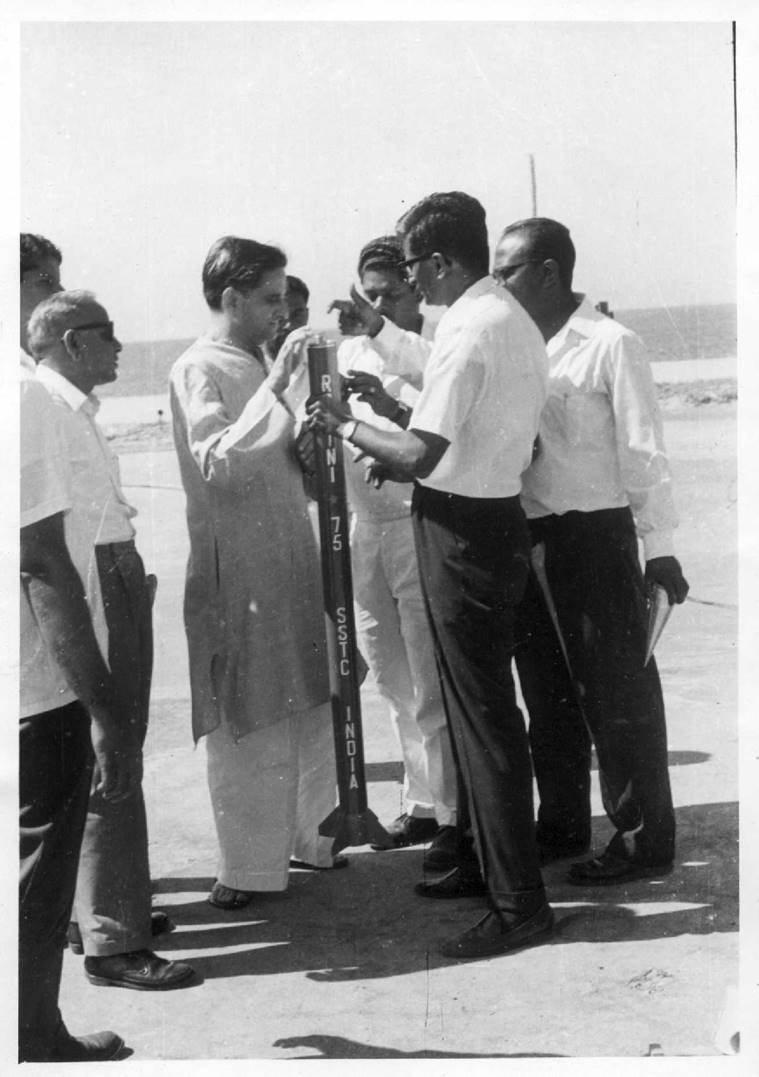
Sarabhai had convinced Parliament and the Planning Commission in 1969 on the merits of “decade profile”, as he envisioned the Indian nuclear programme. The short-term goal-oriented approach, followed especially in universities, might have disappointed him today. In 1966, when Sarabhai took over as Atomic Energy Commission chairman after Homi Bhabha’s death in a plane crash, he started a dialogue with NASA that formed the base for Satellite Instructional Television Experiment. Launched in 1975 from village Pij in Gujarat’s Kheda district, it would beam TV programmes to villages and was the first Indo-US space venture using technology for education. This was how the Krishi Darshan programme for farmers on Doordarshan was conceived.
Sarabhai extended his research emphasis even to business, when he founded Sarabhai Chemicals in Vadodara in 1943, and subsequently the Sarabhai Research Centre and the Operations Research Group. According to Mallika, had her father been alive, “a lot of things in India would have been very different. Because there have been very few people who have the deep commitment, the wherewithal, the world view and the power to sway policy making”.
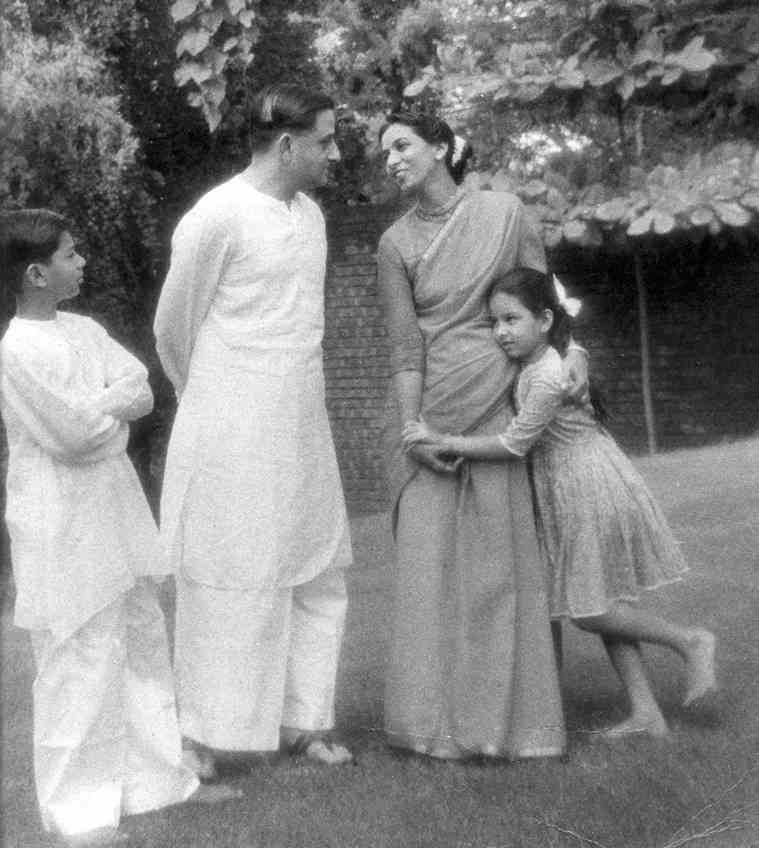
A man of many parts, Sarabhai’s students and colleagues would often wonder how he found the time for everything. Ahmedabad-based architect Kamal Mangaldas remembers how Sarabhai one day asked for a site plan for a project for the Electronic Corporation of India Ltd in Hyderabad which had been awarded to him and well-known architects Balkrishna Doshi and Charles Correa. “After seeing the plan, he came back in 10-15 minutes and changed everything,” says Mangaldas, who designed Sarabhai’s study outside their home on the banks of Sabarmati. “Later I watched it get washed away in the floods after Vikrambhai’s death,” he says.
Last year, Ahmedabad dedicated its first public memorial to Sarabhai — a statue of him seated on a desk overlooking the river, right below the patch where once stood his study.
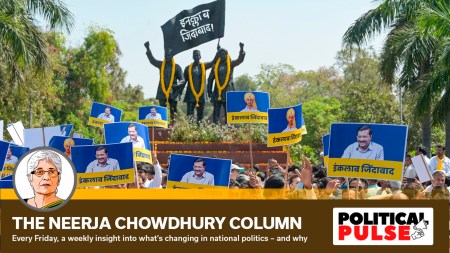
Kejriwal's arrest: Has BJP over-reached or is it a decisive Subscriber Only
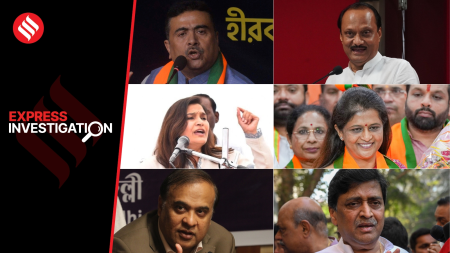
25 Oppn leaders facing corruption probe joined BJP; 23 got Subscriber Only
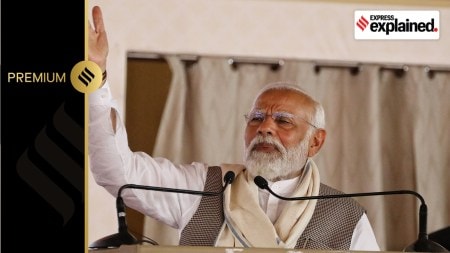
Katchatheevu & Wadge Bank: Story of two India-Sri Lanka agreements Subscriber Only
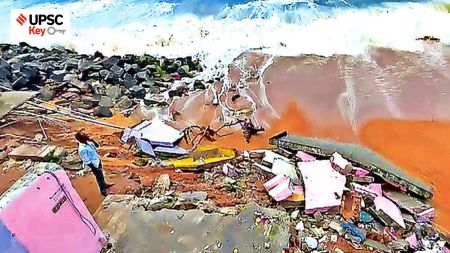
UPSC Key— 3rd April, 2024: Kallakkadal, India’s new geopolitics Subscriber Only
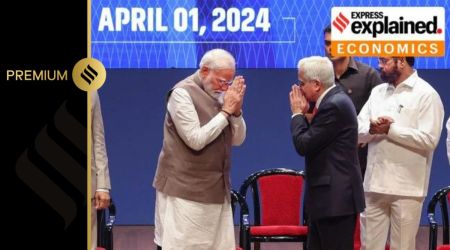
90 years of RBI: Its history, how it navigated times Subscriber Only
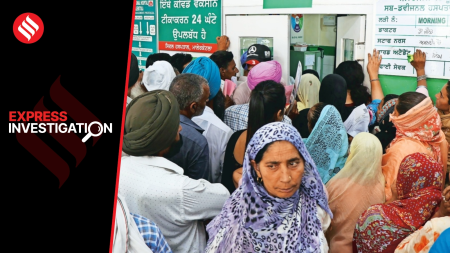
Under Ayushman Bharat, top treatments: cardiology, cancer Subscriber Only
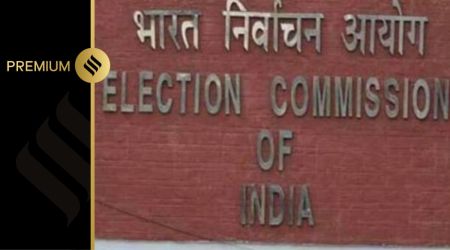
EC deliberates response to Oppn alarm over central agencies action Subscriber Only

How will T+0 settlement cycle benefit investors? Subscriber Only
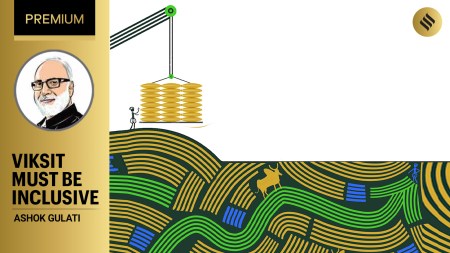
Viksit Bharat must also be inclusive Bharat Subscriber Only

Why Katchatheevu is causing a splash in Tamil Nadu poll Subscriber Only
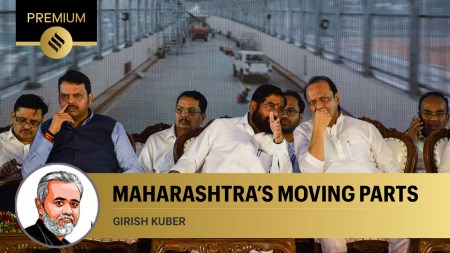
In Maharashtra, BJP is challenged by its own machinations Subscriber Only
- Saluting Bravehearts
- Vikram Sarabhai

The CBCI has issued guidelines for educational institutions in India to promote religious and cultural sensitivity. These guidelines recommend respecting all faiths, avoiding imposing Christian traditions on students of other religions, reciting the Constitution's Preamble, and setting up an inter-religious prayer room.
- Stock Market Live Updates: Sensex, Nifty open at record high 21 mins ago
- Arvind Kejriwal Arrest Live Updates: Delhi HC to give verdict on CM's plea against arrest by ED in excise policy case 29 mins ago
- Lok Sabha Elections 2024 Live Updates: 'Can't raise anti-Sanatan slogans or abuse wealth creators', Gourav Vallabh quits Congress 32 mins ago
- JEE Main 2024 Session 2 Live Updates: BTech, BE paper 1 today; exam guidelines 59 mins ago

Best of Express
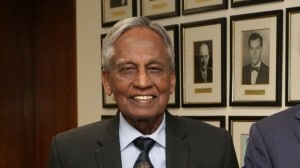
Buzzing Now

Apr 04: Latest News
- 01 Seat-sharing uncertainties in MVA: Uddhav offers Mumbai North & North Central to Congress, Patole says talks on
- 02 Chess: Why Candidates is a tournament of suffering, a ‘lethal combination’ of physical and mental endurance
- 03 WhatsApp, Instagram services restored after global outage
- 04 9.5L seats available in Maharashtra schools under revised RTE this year
- 05 IPL 2024 Points Table: Kolkata Knight Riders races to top of the table, Delhi Capitals fall to 9th
- Elections 2024
- Political Pulse
- Entertainment
- Movie Review
- Newsletters
- Gold Rate Today
- Silver Rate Today
- Petrol Rate Today
- Diesel Rate Today
- Web Stories
Millennial Matriarchs
Musings on Life and Times: Views, Reviews, Previews, Interviews..and Advice

A Life Too Short: A Tribute to Dr. Vikram Sarabhai
Today all of us as Indians, and the whole world in fact, see India as a technological power, a force to reckon with. It is easy for us to be confident of ourselves, our technical prowess, and our growing economic power. But in the ‘40s and ‘50s? We were a fledgling nation, and even food security was an issue. Many around the world wondered whether we would survive as a country, as a democracy. And at such a time, there were some people who had the daring, the vision and the confidence, to dream of being a country that would make a difference. One of them was Vikram Sarabhai.
‘Vikram Sarabhai—A Life’ by Amrita Shah tells this story well. It is a book which made me feel proud as an Indian; which said individuals can make a huge difference; which revealed glimpses of what it takes to build institutions of excellence; and which, most importantly said that it is possible to be a wonderful, warm, caring and very human person, and a high-achiever at the same time.
We look around us today—India is launching rockets for developed countries, it is accepted as a nuclear power, it is on the forefront of the IT revolution. But how did we get here? This book gives us some insights. I think this is an important role that a biography plays—being able to connect the present with the historical context, through the achievements and the legacy of one person.
And the book gives us glimpses of other very extraordinary individuals who played a part in Vikram’s life. The book helps one understand the impact that Ambalal Sarabhai or Kasturbhai Lalbhai or Bhabha had on Sarabhai’s work. But though we catch glimpses of the next generation–Dr Kalam, Mr Seshan, Kiran Karnik or Madhavan Nair—we don’t get an insight into how they, as people and professionals, were impacted by Sarabhai. But that’s probably another book!
The book chronicles well the span and breadth of Sarabhai’s achievements—from pure research to scientific administration; from running a pharmaceutical concern to laying the foundation for management education as we know it today; from market research to bringing in scientific approaches to looking at industrial operations; from space to atomic energy. But what it does even better is to reveal that he set out on each of these diversified ventures with a clarity of purpose and a remarkably unified approach to seemingly very different issues. Sarabhai knew what he was doing. He was not a vain man, but definitely he had no doubts about his ability to take on the most impossible-seeming jobs—even when older and wiser heads thought otherwise. His charm and charisma, which probably helped him overcome many an obstacle, come through. But what also comes through is that his relationship with people was based on a real sense of caring. He did not set out to charm people for what he could get out of them, but probably ended up charming because he was a warm, caring and joyous person who believed in people and respected them.
Vikram the father, Vikram the husband, Vikram the boss, Vikram the son, Vikram the scientist, Vikram the manager—they are all there. Maybe not in depth but definitely outlined evocatively enough to give one a flavour of the person in his multiple roles.
The book is remarkably non-judgmental and matter-of-fact. Though Ms. Shah says that Vikram Sarabhai was a childhood hero and that is why she set about writing his biography, she seems to have been able to resist the temptation to fuzz not-so-pleasant realities. Whether it is his marriage, or his inability to really assert himself and take a firm stand vis a vis individuals in the Department of Atomic Energy, it is told like it was.
I would like to thank Amrita Shah for this biography. We cannot afford to forget our heroes—and Vikram Sarabhai was certainly one of them.
–Meena
Vikram Sarabhai, A Life by Amrita Shah was published in 2007. It is reviewed today to commemorate Dr. Sarabhai’s birthday which falls on 12 August.
The Millennial Matriarchs both count Ahmedabad as home and have worked in institutions which were part of Vikrambhai’s dream. I had the additional good fortune of living on the campus of IIM Ahmedabad as a faculty-spouse. In a large part, we owe what we are to him, albeit indirectly.
Share this!
Published by millennialmatriarchs
View all posts by millennialmatriarchs
7 thoughts on “ A Life Too Short: A Tribute to Dr. Vikram Sarabhai ”
How many of us even know what all Dr Sarabhai did, leave apart appreciate its importance in what India is today. Would get this biography to read after going through this inspiring review. Having read a couple of biographies in past six months, I also feel that schools should have two biographies a year prescribed for children. With hardly any role models in this age and time, reading such biographies may inspire them for something great.
Like Liked by 1 person
A True Incident
One day, many years ago, near the Trivandrum sea shore, an elderly gentleman was reading the Bhagavad Gita. That time, a young talented atheist guy came and took his seat by the side of that gentleman. The young guy taunted the gentleman by saying that in the age of science, only foolish people prefer to read old fashioned books like the Gita.
He further said that, had the gentleman devoted the same time to science, then by now the country would have scaled great heights.
The gentleman did say nothing but asked the young man for his introduction to which the youth replied that he was a science graduate from Kolkata who had come to make his career in Bhabha Atomic Research Center.
The youth further told the gentleman to devote his attention to scientific research as by reading the Bhagavad Gita, he wouldn’t be able to achieve anything. The gentleman simply smiled and rose up to leave. As soon as he got up, four security guards surrounded him and his driver brought his red beacon fitted official car. Seeing all these the youth panicked and asked the gentleman, ‘Who are you?’ The gentleman now replied with a smile and said that his name is Vikram Sarabhai, the Chairman of the same organization, where the youth had come to make his career. At that point of time, there were 13 research organizations in the name of Vikram Sarabhai, along with which he was also the Chairman of Commitee for Atomic Planning, having being appointed to the same by the PM Indira Gandhi. Now, it was the turn of the youth to be ashamed and he fell down on Sarabhai’s feet, crying profusely. It was then that Sarabhai said a very wonderful thing.
He said, “Behind every creation, there’s always the Creator. So, it doesn’t matter, whether it is the time of the Mahabharata or today’s India. Never Forget God !!! Today’s atheist people, by invoking the name of science, may dance as much as they want but history is witness that science has been created by the God- believer theists only. *God is Eternal Truth. God’s speech (Bhagavad Gita) is true; it cannot be falsified at all. Just by worshipping it, troubles will surely get resolved.*
Tribute to Vikram Sarabhai on his 99th Birth Anniversary!!
Amazing story. Thanks for sharing this!
Vikram Sarabhai was non-believer. This is cooked-up story. Vikram Sarabhai, Satish Dhawan, K. Kasturirangan and others who’ve been known to be non-believers, says Bhargava (founder director of CCMB). https://www.livemint.com/Politics/JRJRJ0dSACLKNoltbZ3HLO/For-Indian-scientists-no-conflict-with-God.html
1979, did you write? Or was it 1969? or some other year? Vikram Sarabhai passed away in early 70’s.
Dear Mr. Dibyendu,
Well pointed out. Have removed the date from the comment.
thanks! meena
Well, I was hoping you would find out the correct year and post it. You do have the email address of the poster so please could you enquire and put the date right?
Not having a date there will put a lingering suspicion about the incident.
Leave a comment Cancel reply

- Already have a WordPress.com account? Log in now.
- Subscribe Subscribed
- Copy shortlink
- Report this content
- View post in Reader
- Manage subscriptions
- Collapse this bar
- IAS Preparation
- UPSC Preparation Strategy
- Vikram Sarabhai
Vikram Sarabhai Biography for UPSC
The pioneer of Space research in India and a notable physicist, Vikram Sarabhai, has made remarkable contributions to the astronomical and nuclear fields of India. Known as the “Father of the Indian Space Program”, his contributions have created a profuse reverence in Indians for science and the scientific fraternity.
His life was a rare combination of a genuine passion for science and sustained interest in other fields like dance, theatre, and music. His potential was unmatched by any scientific brain the country has ever seen. He ran the Atomic Energy Commission (AEC) and Indian Space Research Organisation (ISRO) as the premier scientific institutions of India.
This topic can be referred for Science & Technology Notes for the UPSC Exam .You can get an understanding of the space research in India and the contributions of Vikram Sarabhai from the article.
Ace your UPSC Preparation with UPSC Current Affairs from BYJU’S.
Vikram Sarabhai – Download PDF Here
Early Life of Vikram Sarabhai
- Vikram Sarabhai hailed from the famous Sarabhai family of industrialists, who were part of the Indian Independence movement.He was born on August 12, 1919 , to Ambalal Sarabhai and Sarladevi Sarabhai. His family had an enlightened outlook and refined attitude towards culture and education.
- The warm demeanour and progressive mindset made their home a living space for many prominent people, including political leaders, freedom fighters, and social workers. It included Mahatma Gandhi, Rabindranath Tagore, J. Krishnamoorthy, Motilal Nehru, Jawaharlal Nehru, Maulana Azad, Sarojini Naidu, Srinivasa Sastri, and C.F Andrews.
- They lead a simple life without much luxury and pomp. His parents wanted their children to be productive, honest, and lead a well-anchored life. Vikram received his elementary education from the Montessori system. The Sarabhai family followed Jainism and were ritualistic. They enthusiastically participated in the freedom movement and were a part of the Dandi march led by Mahatma Gandhi.
- The foundations of his intellectual career were laid in Retreat school. After completing his Matriculation, he joined Gujarat College, the first college in the state started by the British. Vikram was fond of Sanskrit poetry, particularly the works of Kalidasa, including Meghadootam and Vikramorvasiyam. He pursued his higher education at Cambridge University with a letter of recommendation from Rabindranath Tagore.
- After completing his undergraduate courses in Physics and Chemistry, he returned to India and joined the Indian Institute of Science (IISC). At IISc, he researched Cosmic rays and had serious interactions with C.V.Raman, the first Nobel laureate from India. He also met another stalwart from Cambridge, the founder of India’s Atomic Energy Programme, Homi.J.Bhabha.
- In August 1942, he married Mrinalini Swaminathan, sister of Captain Lakshmi Sehgal of the Indian National Army by Subhash Chandra Bose.
- In 1943, Vikram studied Cosmic rays at high altitudes in Kashmir and shifted his research topic to “time variations of cosmic rays”.In 1945, after the end of the Second World War, he returned to Cambridge and completed his Ph.D. Degree.
- Vikram always believed that India has the potential to build anything, tackle any problems, or solve them through technology and science. To tailor the needs of society, he advocated the replacement of obsolete technologies with new ones. He prompted people to acquire necessary skills from foreign lands and apply that knowledge within the country.
Early Organisational activities
- Things were not easy in the early years of the Indian Space Program. In an age of unsophisticated enthusiasm for technology, Sarabhai, with his scientific eminence and disarming personality, strived his best to upgrade the scientific temper of the country. He tried different combinations of skills, new institutional arrangements, and aspects to deal with problems he was interested in.
- He planned to create a nuclear centre for agriculture, with the competence of both agricultural scientists and nuclear scientists, along with the resources and assistance of the Indian Council of Agricultural Research .
- He also started a joint venture between All India Radio and ESCES (Experimental Satellite Communication Earth Station) to promote television as an instrument of mass communication and increase food production. These novel institutional structures challenged the traditional models of problem-solving in India.
Swastik Mill
- He opted to solve industry-related problems scientifically. In the oil seeds market, he calculated the market prices of ground nuts and seeds and graphically plotted them to obtain a statistical analysis. The application of research methodology to analyse the data and marketing activities garnered fruitful results and contributed towards making a strong organisation.
- He applied human relations techniques and solved the problems between the employees and management.
Sarabhai chemicals
- Despite the presence of top names in the pharmaceutical industry, like Ranbaxy, Cipla, Cadila, Glaxo, and Pfizer, Vikram launched professionally managed Sarabhai chemicals. He collaborated with J.R Geigy, the manufacturer of the whitening agent,’ Tinopol’, which produced heavy profits in the market. Sarabhai chemicals collaborated with a German company and started manufacturing Vitamin C.
Indian Institute of Management Ahmedabad
- Vikram believed that the dearth of efficient managers and the lacking proper management skills were responsible for the downfall of many public and private industries in India.in 1956, He started Ahmedabad Management Association (AMA) along with Kasturbhai Lalbhai to conduct research and impart training to employees of organisations. It later transformed into the Indian Institute of Management (IIM) in 1962.
- He managed to elevate the institution to the next level through collaboration with the prestigious Cambridge University. Vikram set up this premier management institute amidst the challenges from Ford Foundation, which was along the same path. He handed over the position of director of IIM-A to Ravi Mathai as he got preoccupied with space research and later assumed Homi.J.Bhabha’s Atomic Energy Commission (AEC).
- By 1957, Vikram had become a part of the International fraternity, along with scientists like Bruno Rossi, James Van Allen, etc.
“Father of Space Program of India”
- The birth of the Space Age of India started with two stalwarts coming together to use science and technology as a tool for national development. Post-Independence, Jawaharlal Nehru, who had a firm conviction that Science and Technology could solve many social and economic problems, supported both of them to pursue their respective path in science.
- He emphasised the importance of the space program through his quote,” There are some who question the relevance of space activities in a developing nation. To us, there is no ambiguity of purpose. We do not have the fantasy of competing with economically advanced nations in the exploration of the moon or the planets or manned space flight . “
Physical Research Laboratory (PRL)
- Vikram Sarabhai founded PRL on November 11, 1947, as a National Research Institute for Space and Allied sciences. Aided by the Department of Space and Allied Sciences, the Government of India, it conducts several research programs in Astronomy and Astrophysics, Atmospheric Sciences and Aeronomy, Earth Sciences, Solar System studies, and Theoretical Physics.
- Located in Ahmedabad, it conducts the PLANEX (Planet research and exploration program). It gives away awards, including the ‘Hari Om Ashram Prerit Vikram Sarabhai Research Award’ and ‘PRL award’ to scientists who have made exceptional contributions to the field of science and technology.
Indian National Satellite System (INSAT)
- At the Bombay National Electronics Conference in 1970, Vikram Sarabhai announced plans to launch an Indian National Satellite. ISRO launched these multipurpose geostationary satellites to boost telecommunication, meteorology, and broadcasting.
- Sarabhai’s INSAT was similar to a direct-broadcast satellite to educate villages through television. Commissioned in 1983 as a joint venture of the Department of Space, Department of Telecommunications, India Meteorological Department , and All India Radio and Doordarshan, it became the largest domestic satellite communication system in the Asia-Pacific region.
INCOSPAR ( Indian National Committee for Space Research )
- The International Council for Science created a committee on space research known as COSPAR in 1958. It was a response to the launch of Sputnik – 1 by Russia. Homi J Bhabha was entrusted with a responsibility by the Indian government to facilitate research for the Department of Atomic Research (DAE). Bhabha created an Indian counterpart of COSPAR, known as INCOSPAR, with Vikram Sarabhai as the Chairman.
- Mr.Sarabhai organised a six-day seminar in Space Science at the Physical Research Laboratory (PRL) in Ahmedabad.
- By the early 1960s, close ties with the Soviet Union facilitated Space Research in India through the Indian Space Research Organisation (ISRO). This collaboration also allowed the expansion of nuclear power in India even after the Nuclear Bomb test in Pokhran, Rajasthan.
- Following the death of Homi Bhabha in 1966,Vikram Sarabhai assumed the position of the Chairman of the Atomic Energy Commission and secretary of the Department of Atomic Energy (DAE).In the 1960s, they established four important institutions:
1. Space Science and Technology Centre (SSTC)
2. Experimental Satellite Communication Earth Station (ESCES, 1967)
3. Sriharikota base (Sriharikota High Altitude Range,SHAR, now renamed as Satish Dhawan Space Centre(SDSC)
4. Indian Satellite System Project (ISSP).
- Vikram Sarabhai modernised ISRO to its present form in 1969, and managed all the space activities of the country. Physical Research Laboratory (PRL), the brainchild of Vikram, conducted basic research in myriad fields, including aeronomy, cosmic rays, interplanetary space, and solar activity. TIFR was the cradle of India’s Atomic Energy Program.
- A sounding rocket programme was launched with the collaboration of NASA ( U.S), CNES ( France), and Hydrometeorological Services (USSR). Bhabha Atomic Research Centre (BSRC), earlier known as DAE, was entrusted with the local manufacturing of rockets.
- The Space Science and Technology Centre (SSTC) was established to develop sounding rockets of superior performance, a modest satellite launcher and aerospace engineering.
Learn more about the background of the Indian National Committee for Space Research here:
Indian Space research Organisation (ISRO)
- Indian Space Research Organisation was established in 1969 by Vikram Sarabhai and continued with its vision of developing new launch vehicles. After the successful development of the Sounding rocket programme in the 1960s, Satellite Launch Vehicle-3 (SLV – 3) and Augmented Satellite Launch Vehicle (ASLV) was launched.ISRO also developed Polar Satellite Launch Vehicle (PSLV) and Geosynchronous Satellite Launch Vehicle (GSLV).
- The headquarters of ISRO is in Antariksh Bhavan, Bangalore, and was brought under the Department of Space in 1972.
Satellite Launch Vehicle (SLV)
- SLV was a four-stage solid fuel light launcher. It was expected to carry a payload of 40 kg and reach a height of 500m. Launched in 1979, SLV was the dream of Vikram Sarabhai. After its final launch in 1983, it was decommissioned. However, this paved the way for more refined versions in the years that followed.
Augmented Satellite Launch Vehicle (ASLV)
- ASLV was a five-stage solid propellant ,with the capability of holding a 150 kg satellite. Intending to place payloads in Geostationary Transfer Orbits, ISRO developed ASLV by the end of the 1980s. The first launch test in 1987 was followed by 3 others in 1988, 1992, and 1994. Two of them were successful. However, it was decommissioned later.
Polar Satellite Launch Vehicle (PSLV)
- With the advent of PSLV, India launched its Indian Remote Sensing satellite into sun-synchronous orbits. Until then, only Russia had the technology for the same.PSLV can also launch small satellites into Geostationary Transfer Orbit (GTO). It successfully launched almost 30 satellites over these years.
Geosynchronous Satellite Launch Vehicle ( GSLV)
- GSLV was introduced by India, to launch its Indian National Satellite Systems (INSAT ) into Geostationary Transfer Orbit. The primary reason behind these was to make India less dependent on foreign rockets. It serves as ISRO’s heaviest rocket launch vehicle with a capacity of putting a total payload of up to 5 tons into low earth orbit.
Aspirants can go through the List of Space Centres and Indian Space Agencies from the linked article.
- After assuming charge as the Chairman of the Atomic Energy Commission, he proposed a model of the Agro-Industrial Complex to boost the energy program in India. This plan was augmented by MS Swaminathan, the father of the Green Revolution in India.
- He also participated in the 14th general conference of the International Atomic Energy Agency in Vienna. He played an important role in the development of indigenous nuclear technology for defense.Projects initiated by him include the Fast Test Reactor in Kalpakkam and Variable Energy Cyclotron project in Calcutta.
Read the article on Satellite Launch Vehicle Program and get a better understanding of the Polar Satellite Launch Vehicle (PSLV) and Geosynchronous Satellite Launch Vehicle (GSLV)
Democratic Outlook
- His democratic outlook in companies was highly appreciated. He believed that every employee of his company should get a chance to speak on the prevailing issues, challenges, and competencies. He delegated tasks to all employees and ensured a democratic outlook in every sphere of the organisation. He sent his delegates to foreign lands to visit markets, textile mills, and laboratories to acquire new skills and the latest technologies.
Later Years
- He passed away due to cardiac arrest at an age of 52 on 30 December 1971.
- He was awarded the second-highest civilian honour of the country, Padma Vibhushan, in 1972, and the third-highest civilian honour of the country, Padma Bhushan, in 1966.
Important Institutions founded by Sarabhai
- PRL – Physical Research Laboratory in Ahmedabad
- IIM – Indian Institute of Management, Ahmedabad
- CSS – Community Science Centre, Ahmedabad
- Darpan Academy for Performing Arts, Ahmedabad (along with his wife)
- VSSC – Vikram Sarabhai Space Centre in Thiruvananthapuram
- Space Applications Centre in Ahmedabad
- FBTR – Faster Breeder Test Reactor in Kalpakkam
- Variable Energy Cyclotron Project in Calcutta
- ECIL – Electronics Corporation of India Limited in Hyderabad
- UCIL – Uranium Corporation of India Limited in Jaduguda, Bihar
- ISRO named the lander of its second mission to the moon, CHANDRAYAAN, ‘Vikram’ in memory of Vikram Sarabhai.
- Vikram Sarabhai Space Centre, the lead centre of the Indian Space Research Organisation, is named after Vikram Sarabhai.
- The Indian Astronomical Union named a lunar crater after Sarabhai,known as “Sarabhai Crater”.
- ‘Vikram A Sarabhai’ community centre in Gujarat is named after him.
- ISRO has announced an award known as Vikram Sarabhai Journalism Award in Space Technology and Research as part of centenary year celebrations of Dr. Vikram Sarabhai
- Vikas, a liquid fuelled rocket engine by ISRO is named after him.
Frequently Asked Questions about Vikram Sarabhai
Is Vikram Sarabhai the founder of ISRO?
After Russia launched the Sputnik satellite, Sarabhai felt the need to have a space agency for India. The National Committee for Space Research was established by the Indian Government( INCOSPAR) on his recommendations, which was later renamed ISRO.
What are the achievements of Vikram Sarabhai in Space Research?
Vikram Sarabhai was a visionary and an outstanding scientist who worked for the development of the nation through the application of modern technology. He was instrumental in setting up the Indian National Committee on Space Research.
Which is the largest centre of ISRO?
Vikram Sarabhai Space Centre (VSSC) located in Trivandrum, is the lead centre of the Indian Space Research Organisation, which manages the design and development of launch vehicle technology.
Where did Vikram Sarabhai begin his research on cosmic rays?
Vikram Sarabhai started his experiments on cosmic rays at the Physical Research Laboratory (PIL) in Ahmedabad in 1947 at the age of 23.
Why is Vikram Sarabhai known as the “father of the Indian Space Programme?
Vikram Sarabhai is known as the “father of the Indian Space Programme” as he pioneered space research in India, and his sustained efforts in the field have helped India achieve a place on the International map in space research.
When did Vikram Sarbhai become the chairman of the Atomic Energy Commission of India?
Vikram Sarabhai became the Chairman of the Atomic Energy Commission of India in 1966, following the death of Homi J Bhabha.
Note : Aspirants can go through notes for Science & Technology Notes for UPSC Exam to ace their preparation for IAS Exam.
Follow Daily News Analysis for UPSC and stay updated on daily current affairs.
Related Links:
Leave a Comment Cancel reply
Your Mobile number and Email id will not be published. Required fields are marked *
Request OTP on Voice Call
Post My Comment
IAS 2024 - Your dream can come true!
Download the ultimate guide to upsc cse preparation.
- Share Share
Register with BYJU'S & Download Free PDFs
Register with byju's & watch live videos.
- Skip to main content
- Skip to primary sidebar
- Skip to secondary sidebar

Indiaonlinepages.com - All about India!
Vikram Sarabhai Biography: Age, Birth, Education, Career, Achievements, Death Story and Other Details
Vikram Sarabhai was born on 12 August 1919 in Ahmedabad, Gujarat state in western India, and he passed away on 30 December 1971, at 52 years of age.
Vikram Sarabhai is a name that Indians will always have immense respect for.
In today’s age, we enjoy cricket matches from the comfort of our homes, get regular weather updates, get information on upcoming cyclones, enjoy ISRO’s achievements, or sit comfortably because our borders are protected.
All of this is possible via satellites, and this is where Vikram Sarabhai’s contribution to India can never be forgotten.
In today’s post, we will go through the biography of India’s pioneer, Vikram Sarabhai and discuss details about his education, career, achievements, inventions, family, death, etc.
Vikram Sarabhai Biography
Vikram sarabhai age, birth, parents and childhood.
Vikram Sarabhai was born on 12 August 1919 at the conclusion of the 1st world war. Vikram was born into an affluent family in Ahmedabad, Gujarat.
This was a time when India was in the grip of British rule, and most of the families in India did not have access to basic amenities, let alone proper educational infrastructure.
However, Vikram’s family was influential across India, as his father, Mr. Ambalal Sarabhai, was one of the richest businessmen in Ahmedabad, and his mother was Mrs. Saraladevi Sarabhai.
Mr. Ambalal Sarabhai owned many mills in Gujarat and was also an active part of India’s independence movement.
Vikram was one of the eight children of his parents, and also the youngest. A lot of credit for Vikram’s success goes to his parents, who could identify the talent in Vikram’s early years.
Vikram’s schooling was very different from the rest of the Indian kids, as his father introduced a different and unique style of education for him, also known as Montessori education.
This style of education focuses mainly on children’s natural interests and activities rather than formal teaching methods.
When Vikram was only 6 years old, he used to assemble parts of railway engines, bogies, signals, and stations.
To take his passion to the next level, Vikram’s parents help him set up a mechanical workshop, along with the instructors and 2 engineers.
At a very early age, Vikram with the help of two engineers made a miniature steam engine with tracks. Today, this piece of art is preserved at the Community Science Centre in Ahmedabad.
In a way, Vikram Sarabhai was also influenced by a lot of famous personalities of that time, such as Gurudev Rabindranath, Motilal Nehru, Jawaharlal Nehru, Sarojini Naidu, Maulana Azad, etc.
Due to his parents’ involvement in India’s independence movement, a lot of these people used to visit Vikram’s house in Ahmedabad.
As a matter of fact, Mahatma Gandhi also once stayed at their house while recovering from an illness.
Vikram Sarabhai Education
Vikram Sarabhai at the end of his Montessori education at home took up the matriculation, Class 10th examination as an external candidate from RC High School, Ahmedabad.
Although his favourite subject was Science, he practiced and mastered other subjects as well, such as mathematics and arts.
To complete Class 12, Vikram took the examination at Gujarat College under Bombay University. He was also the top scorer amongst his peers in Physics as well as Chemistry.
Impressed by Vikram’s academic proficiency, the famous Indian poet Rabindranath Tagore even wrote a letter of recommendation to Cambridge University, stating:
“ Vikram is a young man with a keen interest in Science. He comes from a wealthy cultured family, he is a fit and proper person for admission to the university “
As a result, Vikram got accepted and moved to England to pursue Tripos in Natural Sciences, for which he was awarded a degree in 1940.
However, that was also the time when World War 2 was in full action, and a lot of Jewish scientists in Europe were moving to the US because of the execution of Jews all over Europe.
Due to all this, Vikram’s father, Ambalal got worried and insisted Vikram to come to India immediately.
Since Vikram was a bright student, he was allowed by Cambridge University to continue his PhD under the guidance of Sir C.V. Raman, a Nobel laureate, at Indian Institute of Science (IISC), Bangalore.
Soon after this, Vikram started his research studies on cosmic rays from space in 1940 and in 1943, he went to Kashmir to measure cosmic rays at high altitude.
During this time, he got married to Mrinalini Swaminathan, a famous Bharatanatyam dancer in August 1942.
As soon as the second world war ended in 1945, Vikram along with his wife Mrinalini went back to England to complete his PhD studies.
He was finally given a PhD degree in 1947 by Patrick Blackett, a Nobel laureate in Nuclear Physics and cosmic radiation.
Vikram Sarabhai Family (Wife and Children)
While Vikram was doing his research at IISC, he became interested in art, music and dance. It was during this time he met famous Bharatanatyam dancer Mrinalini Swaminathan.
Mrinalini was born on 11 May 1918 in Chennai, and she was older than Vikram by a small margin.
Mrinalini was not just a dancer, but she was also a social activist, who used her art to address current social issues.
Eventually, Vikram and Mrinalini got married in August, 1942.
By that time, the ‘Quit India’ movement had already started and Vikram’s sister Mridula was arrested, due to which his family could not attend the wedding, except for his driver, Lala.
On 27 November 1947, the couple had their first child, Kartikeya Sarabhai and on 9 May 1953, Mrinalini gave birth to a daughter, Mallika Sarabhai.
Both their children were able to take the legacy of their parents to the next level as Mallika became an actress and an activist.
Kartikeya is one of the world’s leading environmental educators, and he was awarded the Padma Shri, India’s fourth-highest civilian award, in 2012.
Vikram Sarabhai Career and Achievements
Vikram Sarabhai’s career is an undisputed example of determination and perseverance. In the 21st century, life of people cannot progress without the use of information and information is available via satellites.
There are 195 countries in the world, and not every country has a footprint in space. The credit for India’s success in space research goes to Vikram Sarabhai.
Homi Jehangir Bhabha, who is also known as the Father of India’s nuclear power program graduated from Cambridge University 10 years before Sarabhai.
When Vikram was studying at IISc, Homi Bhabha was working as a reader there.
This was merely a coincidence, since these two formed a strong partnership to take India to the next level in the field of science, nuclear power and technology.
When Vikram came back to India after getting his PhD degree, he formed Physical Research Laboratory (PRL) in Ahmedabad on November 11, 1947 with the help of his friends and family members.
During the same year (1947), Vikram also formed Ahmedabad Textile Industry’s Research Association (ATIRA).
Even though Vikram had no formal idea about how textile industries work, it was the need of the hour in young India at that time.
In 1949, Vikram along with his wife Mrinalini established an art institution called “Darpana Academy of Performing Arts” in Ahmedabad. This was an ideal platform for young Indians to get trained in various arts like music, dance, drama etc.
Interestingly, Vikram Sarabhai was involved in the renaissance of the pharmaceutical industry in India. He believed from the start, that this industry should have the highest quality standards.
To achieve this, he collaborated with European and American countries and started the manufacturing of medicines like vitamins, penicillin, etc. in 1956, which are essential for the masses in any country.
Due to this reason, India has now become self-reliant in the pharmaceutical industry.
There was a time when Vikram Sarabhai was leading multiple industries and was working almost 20 hours a day along with a lot of travelling.
During the years 1955-1962, Vikram also used to travel to the US to teach students at MIT, Boston.
This gave him an opportunity to collaborate with the Government of India, esteemed businessman Kasturbhai Lalbhai of Ahmedabad, The Harvard Business School to establish Indian Institute of Management in Ahmedabad in 1961.
Vikram Sarabhai Contribution to ISRO and Space
The idea for India’s space adventure seeded when the USSR launched a satellite into space for the first time in the world on 4th Oct 1957.
This gave Vikram Sarabhai an opportunity to speak to the PM of India Jawaharlal Nehru and convince the government of India to have their own space program.
According to Vikram Sarabhai, “if India is to play a meaningful role nationally, and in the community of nations, we must be second to none in the application of advanced technologies to the real problems of man and society.”
In this initiative, Vikram was well supported by Homi Bhabha.
As a result, INCOSPAR (Indian National Committee on Space Research) was launched under DAE (Department of Atomic Energy) in 1962.
The aim of this organization was to set up India’s first rocket launching station at Thumba in Kerala.
To facilitate this project, many young engineers were sent for training at NASA. One of those young scientists was APJ Abdul Kalam.
After six months of hard work and dedication, the first sounding rocket of India was launched on 21 November 1963 from “Thumba Equatorial Rocket Launching Station (TERLS)”.
It is even reported that Vikram Sarabhai worked for a token salary of one rupee in view of his personal wealth.
On 1 January 1965, Sarabhai set up the Space Science and Technology Center (SSTC), which was later renamed as Vikram Sarabhai Space Center – VSSC.
However, on 24 Jan 1966, Homi Jehangir Bhabha died in a plane crash, which meant Vikram Sarabhai had to take overall responsibility of Indian nuclear energy research as the Chairman of the Atomic Energy Commission and Secretary of the Department of Atomic Energy.
In the year 1969, INCOSPAR became the Indian Space Research Organisation. This was the time when Vikram Sarabhai started a project to launch an Indian satellite to provide Television for five lakh villages of India (Aryabhata).
In the coming years, Dr Sarabhai was in constant touch with NASA and the European space agency to exchange information, so India could send their own satellite.
Unfortunately, Vikram Sarabhai passed away on 30 December 1971 due to a cardiac arrest.
However, his efforts did not go to vain, as India was eventually able to put their own satellite Aryabhata into orbit on 19 April 1975 with the help of a Russian Cosmodrome.
Vikram Sarabhai Organizations Founded
Vikram sarabhai awards.
As an Indian, one of the highest awards one could receive is a Padma Bhushan. Vikram Sarabhai was given a Padma Bhushan in 1966 due to his contributions to the country.
After his death, Vikram Sarabhai was also awarded with Padma Vibhushan (posthumously) in 1972, which is the second-highest civilian award of the Republic of India, after the Bharat Ratna.
In addition to this, Vikram received several awards such as:
- President of the Physics section, Indian Science Congress (1962),
- Vice-President, Fourth U.N. Conference on ‘Peaceful uses of Atomic Energy’ (1971),
- President of the General Conference of the I.A.E.A., Vienna (1970),
- Vikram Sarabhai Space Centre, (VSSC) named after him
- A crater on the moon ‘BESSEL A’ has been named the Sarabhai crater by the International Astronomical Union in 1973,
- Shanti Swarup Bhatnagar Award (1962)
- Chandrayaan-3 lander was named “Vikram” after Vikram Sarabhai
Vikram Sarabhai Death Cause and Place
Vikram Sarabhai passed away in Thiruvananthapuram, Kerala on 30 Dec 1971, when he was only 52 years of age.
There are a lot of theories about how he died, the one that was reported was massive cardiac arrest.
Padmanabh Joshi, who was a close associate of the Sarabhai family, once revealed that the entire train compartment used to be empty, if Vikram was travelling by train.
In one of his quotes, Vikram also stated “he was being watched by Americans as well as Russians”.
In fact, the famous ISRO scientist Nambi Narayan quoted in his book “Ormakalude Bhramanapadham” that high ranked international personalities were involved in Vikram Sarabhai’s death.
The fact is Vikram Sarabhai’s contribution has changed and shaped the daily life of every Indian, whether we may see it or not.
He has pushed India to a stage, where India has become a global dominant power in the field of science, space and research.
General Studies
All Programmes
Study Material
Vikram Sarabhai
Quest for upsc cse panels.

Sub-Categories:
GS-III: Science & Technology
Prelims : General Science
Mains : Achievements of Indians in Science & Technology; Indigenization of Technology and Developing New Technology.
Dr. Vikram Sarabhai, often referred to as the "Father of the Indian Space Program," was a visionary scientist, space physicist, and astronomer who played an instrumental role in shaping India's space research and exploration endeavours.
His significant contributions to space science and technology have left a profound mark on India's scientific landscape.

Vikram Sarabhai - Background
Dr. Vikram Sarabhai was a renowned Indian physicist and astronomer who played a pivotal role in the development of India's space program. He was a great institution builder who not only established but also assisted in establishing several institutions in various fields.
Early Life and Education of Vikram Sarabhai
- His father, Ambalal Sarabhai, was an industrialist and was associated with the Ahmedabad mill strike of 1918.
- Here, he began research on cosmic rays under the supervision of Sir C. V. Raman .
- After the war, he again returned to Cambridge in 1945 and received a PhD in 1947 for his thesis, “ Cosmic Ray Investigation in Tropical Latitudes ”.
- He studied interplanetary space, solar-terrestrial interactions, and geomagnetism.
- Vikram Sarabhai passed away on December 30, 1971, in Kerala.
After returning to India, Vikram Sarabhai embarked on a fruitful career in academia and research.
- At PRL, he conducted groundbreaking research in cosmic rays and space physics.
- Community Service Centre: He founded the Community Science Centre (later renamed Vikram A. Sarabhai Community Science Centre) under the auspices of the Nehru Foundation for Development.
- ISC: He served as the President of the Physics Section of the Indian Science Congress in 1962.
- Atomic Energy Commission: Vikram Sarabhai was appointed Chairman of the Atomic Energy Commission under the Government of India in 1966 .
- ISRO: He served as the Chairman of the Indian National Committee for Space Research ( INCOSPAR ) from 1962 to 1969 and later served as the first chairman of the Indian Space Research Organisation (ISRO) from 1969 to 1971.
- IAEA: He served as the President of the General Conference of the International Atomic Energy Agency in 1970.
- U.N. Conference on 'Peaceful Uses of Atomic Energy’: He served as the vice-president of the Fourth U.N. Conference on 'Peaceful Uses of Atomic Energy' in 1971.
Contributions of Vikram Sarabhai
Vikram Sarabhai made a number of significant contributions to science and technology, particularly in the fields of space and nuclear technology.
Indian Space Program
- After the Russian Sputnik launch , he successfully persuaded the government of the significance of a space programme for a developing country like India.
- As a result, INCOSPAR was established in 1962 and later renamed ISRO.
- First rocket launching station: Vikram Sarabhai, along with the support of Homi Jehangir Bhabha, set up the first rocket launching station (Thumba Equatorial Rocket Launching Station) in 1963 in India at Thumba near Thiruvananthapuram.
- SITE Project: As a result of Vikram Sarabhai's dialogue with NASA in 1966, the Satellite Instructional Television Experiment (SITE) was launched between July 1975 and July 1976.
- As a result, the first Indian satellite, Aryabhata, was launched into orbit from a Russian Cosmodrome in 1975 .
Nuclear Energy
- He was largely responsible for the establishment and development of India's nuclear power plants, carrying on Bhabha's work in the field of nuclear research.
- He started the Fast Breeder Test Reactor (FBTR) project in Kalpakkam, Tamil Nadu.
Institutes Established by Vikram Sarabhai
Vikram Sarabhai was a visionary and established many institutions in the field of science and technology, which have benefited India in various fields. Some of the famous institutions established by Vikram Sarabhai include
- Physical Research Laboratory (PRL), Ahmedabad
- Ahmedabad Textile Industry’s Research Association (ATIRA), Ahmedabad
- Indian Institute of Management (IIM), Ahmedabad
- Community Science Centre, Ahmedabad
- Operations Research Group (ORG), (India’s first market research agency)
- Darpan Academy for Performing Arts, Ahmedabad
- Vikram Sarabhai Space Centre, Thiruvananthapuram
- Space Applications Centre, Ahmedabad
- Faster Breeder Test Reactor (FBTR), Kalpakkam
- Variable Energy Cyclotron Project, Calcutta
- Electronics Corporation of India Limited (ECIL), Hyderabad
- Uranium Corporation of India Limited (UCIL), Jaduguda, Bihar
Awards and Honours received by Vikram Sarabhai
Following are some of the notable awards and recognitions of Vikram Sarabhai:
- Shanti Swarup Bhatnagar Award , 1962
- Padma Bhushan,1966
- Padma Vibhushan, posthumous, 1972
- It is a research institute specialising in solid and liquid rocket propellants.
- In 1974, the International Astronomical Union in Sydney decided to name a Moon Crater BESSEL in the Sea of Serenity, as the Sarabhai Crater.
- ISRO named the lander of Chandrayaan 2 and Chandrayaan 3 , 'Vikram' in honour of Vikram Sarabhai.
Vikram Sarabhai's extraordinary contributions to science and technology, especially in the space and nuclear sectors, have earned him numerous awards and honours. He instilled a culture of scientific inquiry and research in India, inspiring countless young minds to explore the frontiers of science and technology.
FAQs on Vikram Sarabhai
Who was dr. vikram sarabhai.
Dr. Vikram Sarabhai was a renowned Indian physicist and astronomer known as the "Father of the Indian Space Program " for his pivotal role in establishing ISRO and advancing India's space research.
What is the role of Vikram Sarabhai in ISRO?
Dr. Vikram Sarabhai is widely regarded as the "Father of the Indian Space Programme" by the scientific community. He played a key role in the formation of India's space agency, the Indian Space Research Organisation (ISRO), of which he later served as chairman.
How did Vikram Sarabhai contribute to the field of nuclear energy?
Dr. Sarabhai served as the Chairman of the Atomic Energy Commission and was instrumental in the establishment and development of India's nuclear power plants.
What institutions were established by Vikram Sarabhai?
Vikram Sarabhai was a visionary who established several institutions, such as the Physical Research Laboratory (PRL), IIM- Ahmedabad, Darpan Academy for Performing Arts, and many more.
Kids Portal For Parents India Kids Network
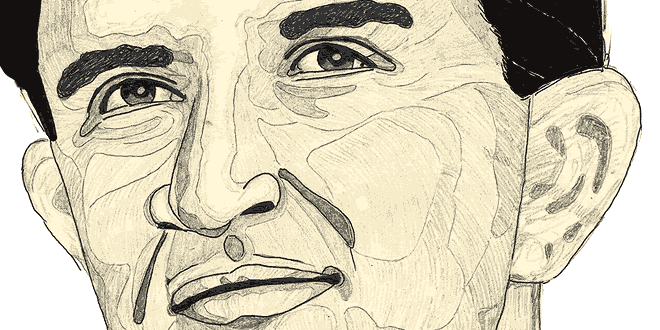
Vikram A. Sarabhai Biography For Students
4to40.com August 11, 2019 Biographies for Kids 7,819 Views
One of the greatest scientists of India . As Chairman of the Atomic Energy Commission, he guided research of the greatest importance to the country. A born scientist and a beloved teacher. ~ P.S.V. Shetty
On his return from the United Kingdom with a Ph.D., he founded the Physical Research Laboratory in Ahmedabad, an institution devoted to the study of cosmic rays and other space. In 1955, he set up a branch of the laboratory at Gulmarg in Kashmir. He also set up other branches in Trivandrum and Kodaikanal.
Vikram A. Sarabhai was born on August 12, 1919, and his wife was similar to Bhabha’s. He, too, belonged to a wealthy family. Had he wished, he could have become an industrialist, but his basic interest was in mathematics and physics? The purpose of the Physical Research Laboratory that he founded was similar to Bhabha’s creation, the Tata Institute of Fundamental Research. It provides the technology and scientists needed for the country’s space programmes, just as the Tata Institute of Fundamental Research provides these for its nuclear programme.
In fact, Sarabhai ushered in the space age in the country by expanding the Indian Space Research Organization. The credit for much of what India achieved in space technology must go to him, though he did not live to see many of the fruits of his labour. Among the projects he planned was the one under which India ‘s first satellite, Aryabhata , was launched in 1975. The Satellite Instructional Television Experiment (SITE) in 1975-76, which sought to bring education to five million people in 2,400 Indian villages, also owes much to Sarabhai.
In one respect Sarabhai went a step ahead of Bhabha. He built a variety of institutions-one devoted to modernization of the textile industry, another to development of management skills and yet another to popularizing science, apart from the Physical Research Laboratory and the Indian Space Research Institute.
Like Bhabha he died at an early age, when he was only 52. He received many honors and awards for his services to science and society. The International Astronomical Union named after him a crater on the moon in the Sea of Serenity.
- Stumbleupon
Tags Greatest Researchers of India Greatest Scientists of India India Famous Biographies India Famous Researchers Biography India Famous Scientists Biography India Images & Videos India Personalities Biography India Popular Researchers Biography India Popular Scientists Biography India Top 10 Researchers India Top 10 Scientists Indian Famous Personalities Life History of India Researchers Life History of India Scientists Life History of Researchers Life History of Scientists Researchers of India Scientists of India
Related Articles
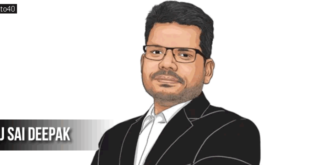
J Sai Deepak Biography, Hindu Right Wing Lawyer, Author
22 hours ago
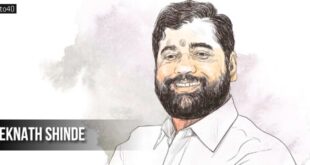
Eknath Shinde Biography, Early Life, Education, Political Career
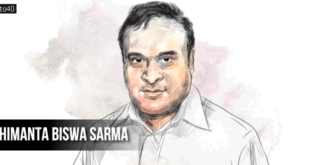
Himanta Biswa Sarma Biography, Early Life, Education, Political Career
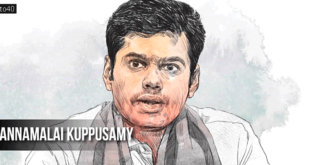
Annamalai Kuppusamy Biography, Early Life, Education, Politics
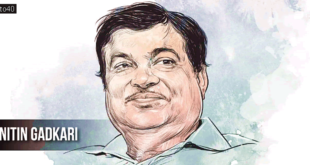
Nitin Gadkari Biography: Early Life, Political Career, Achievements
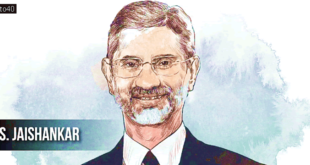
S Jaishankar Biography: Early Life, Personal Life, Political Career

छत्रपति शिवाजी महाराज की जीवनी स्कूली छात्रों और बच्चों के लिए
छत्रपति शिवाजी महाराज (1630-1680 ई.) भारत के एक महान राजा एवं रणनीतिकार थे जिन्होंने 1674 …

- Kerala PSC Exams
- Kerala PSC Notification
- Kerala PSC Exam Calender
- Kerala PSC Previous Question papers
- KAS Previous Year Question papers
- Kerala PSC VEO Notification
- Kerala Police SI
- Kerala PSC LDC Notification
- Kerala PSC LP/UP Assistant
- Kerala PSC Village Field Assistant Notification
- Kerala PSC LD Typist Notification
- Kerala PSC Food Safety Officer
- Kerala PSC Excise Inspector Notification
- Kerala PSC BDO Notification
- Kerala PSC CPO Notification
- Kerala PSC LGS Notification
- Karnataka PSC
- IBPS PO Notification
- IBPS Clerk Notification
- SBI PO Notification
- SBI Clerk Notification
- SBI SO Notification
- SBI Apprentice Notification
- Canara Bank PO Notification
- Indian Bank PO Notification
- RBI Assistant Notification
- RBI Office Attendant Notification
- IBPS RRB Notification
- IBPS RRB Office Assistant Notification
- Spoken English
- Stock Market
- Digital Marketing
- Accounting Course
- Quantity Survey
- Oil and Gas
- Yoga Teaching
- Data Science Malayalam
- Data Science Training in Kochi
- Data Science Training in Trivandrum
- Data Science Course in Calicut
- Data Science Training in Thrissur
- Full Stack Development Malayalam
- Full Stack Development Hindi
- Full Stack Development Tamil
- Full Stack Development Telugu
- Full Stack Development Kannada
- Stock Market Course in Malayalam
- Stock Market Course in Tamil
- Stock Market Course in Kannada
- Options Trading Course
- Spoken English Course in Malayalam
- Spoken English Course in Hindi
- Spoken English Course in Telugu
- Spoken English Course in Tamil
- Spoken English Course in Kannada
- Python Programming Course
- Quantity Surveying Course
- Performance Marketing Course
- Tally Course
- Taxation Course
- UAE Accounting
- Full Stack Developer Course in Kochi
- Full Stack Developer Course in Trivandrum
- Full Stack Developer Course in Calicut
- Full Stack Developer Course in Pune
- Full Stack Developer Course in Bangalore
- Full Stack Developer Course in Hyderabad
- Full Stack Developer Course in Chennai
- Full Stack Developer Course in Indore
- Full Stack Developer Course in Jaipur
- Full Stack Developer Course in Coimbatore
- Digital Marketing Course in Kochi
- Digital Marketing Course in Trivandrum
- Digital Marketing Course in Calicut
- Digital Marketing Course in Kollam
- Digital Marketing Course in Thrissur
- Digital Marketing Course in Kottayam
- Digital Marketing Course in Kannur
- SAP FICO Course
- SAP MM Course
- Montessori Teacher Training in Calicut
- Montessori Teacher Training in Kochi, Ernakulam
- Montessori Teacher Training in Trivandrum
- Montessori Teacher Training in Kollam
- Montessori Teacher Training in Malayalam
- Montessori Teacher Training in Kannada
- German Language Course
- OET Coaching
- Nurses Recruitment Abroad
- ChatGPT Course
- Forex Trading Course
- Yoga Teacher Training Course
- Oil and Gas Course
- Karnataka TET
- KPSC Degree Level Exam Preparation
- Kerala PSC 12th Level Exam Preparation
- Kerala PSC 10th Level Exam Preparation
- KAS Coaching
- Kerala PSC LDC Coaching
- Kerala PSC Fireman Coaching
- KSFE Assistant Exam Preparation
- Kerala PSC SI Exam Coaching
- Khadi Board LDC Exam Preparation
- University LGS Exam Preparation
- University Assistant Exam Coaching
- KPSC Scientific Officer Exam Coaching
- KPSC Probation Officer Grade II
- KPSC Food Safety Officer Coaching
- KTET Coaching
- SET Coaching
- LP/UP Assistant Exam Coaching
- HSST Exam Preparation
- HSA Exam Preparation
- Kerala PSC Lecturer in Diet Coaching
- Kerala PSC Industries Extension Officer Coaching
- KPSC LSGD AE Exam Coaching
- KPSC Civil Engineering Exam Coaching
- KPSC Mechanical Engineering Exam Coaching
- IELTS Training Online
- IBPS SO Online Coaching
- IBPSC PO Online Coaching
- IBPSC Clerk Online Coaching
- SBI PO Coaching
- SBI Clerk Online Coaching
- RBI Grade B Coaching
- RBI Assistant Coaching
- CSEB Exam Coaching
- Kerala Bank Exam Coaching
- JCI Exam Coaching
- UPSC Online Coaching
- SSC JE Online Coaching
- SSC CGL Coaching
- SSC CHSL Coaching
- SSC MTS Coaching
- RRB RPF Exam Coaching
- RRB NTPC Exam Coaching
- RRB JE Online Coaching
- RRB ALP Exam Coaching
- RRB Technician Exam Coaching
- CAT Online Coaching
- GATE Online Coaching
- EMRS Coaching
- CTET Exam Online Coaching

- HTML Tutorial
- DSA Tutorials
- HTML Tutorial for Beginners in Hindi
- Python Tutorial for Beginners in Hindi
- GIT and GITHUB Tutorial for Beginners in Hindi
- JavaScript Tutorial in Tamil
- HTML Tutorial For Beginners in Telugu
- CSS Tutorial for Beginners in Telugu
- Bootstrap Tutorial for Beginner in Telugu
- HTML Tutorial For Beginners in Kannada

Vikram Sarabhai – Inventions, Contribution, Awards, Quotes

Table of Contents
Vikram Ambalal Sarabhai was the man who spearheaded India’s space programme and he is considered as the Father of the Indian space program , Who Orchestrated The First Satellite Launch In The Country. He was born on 12 August 1919 in Ahmedabad, Bombay Presidency. He is popular across the country for establishing the Indian National Committee for Space Research (INCOSPAR), which was renamed later as Indian Space Research Organisation (ISRO). He was honoured with Padma Bhushan in 1966 and the Padma Vibhushan (posthumously) in 1972.
This article gives you a glimpse of Inventions, contributions, awards received, famous quotes and other important facts of the well known physicist and astronomer who initiated space research and helped develop nuclear power in India . Going through this article will be very useful in GK parts for the candidates who are preparing for various competitive exams.

Sarabhai started a project for the fabrication and launch of an Indian satellite. As a result, the first Indian satellite, Aryabhata, was put in orbit in 1975 from a Russian cosmodrome.
In order to promote all round development in the field of science and technology he helped establish several institutions.
Sarabhai along with Homi Jehangir Bhabha set up the first rocket launching station in the country. The Father of India’s space programme Vikram Sarabhai was also the man who brought television and cable to India.
Dr Sarabhai died in December 1971 at Kovalam, Thiruvananthapuram aged 52.
Attempt Free GK Mock Test! Download Entri App!
History and Invention of Vikram Sarabhai
Vikram Sarabhai was born on 12 August, 1919 in the city of Ahmedabad in Gujarat, India. He is one of the eight children of Ambalal Sarabhai and Sarla Devi. He belongs to rich family who managed several textile mills. He passed his intermediate examination in Science subject from the Gujarat College in Ahmedabad and then for further studies he went to England. He was an intelligent student and from his childhood he had an interest in science. In England in 1940, he took admission at the St John’s College, University of Cambridge and pursue Tripos in Natural Sciences. In 1942, he published his first scientific paper ‘Time Distribution of Cosmic Rays’. In 1945, he came back to Cambridge for further research on cosmic rays and earned his PhD degree for his thesis ‘Cosmic ray investigations in tropical latitudes’. In 1947, he came back to India and then joined the Indian Institute of Science in Bangalore to carry out research on cosmic rays.
Sarabhai earned his doctorate from the University of Cambridge, England. After moving to India during World War II.
He did research in cosmic rays under physicist Sir Chandrasekhara Venkata Raman at the Indian Institute of Science, Bangalore.
In 1945 he returned to Cambridge to pursue a doctorate and wrote a thesis, “Cosmic Ray Investigations in Tropical Latitudes,” in 1947.
He founded the Physical Research Laboratory in Ahmadabad on his return to India.
He also established Ahmedabad Textile Industry’s Research Association in 1947.
Sarabhai is also the man behind setting up the Indian Institute of Management, Ahmadabad in 1962.
Vikram Sarabhai established Indian National Committee for Space Research (INCOSPAR) in 1962 which was renamed later the Indian Space Research Organization (ISRO).
He should be majorly credited for setting up the Thumba Equatorial Rocket Launching Station in southern India.
In 1966, Dr Sarabhai took charge as the chairman of the Atomic Energy Commission of India after the death of physicist Homi Bhabha.
He is the face behind foundations for developing India’s indigenous nuclear technology for defence.
Vikram Sarabhai worked immensely to launch India’s first satellite, Aryabhata.
Indian Space Program
The establishment of the Indian Space Research Organization (ISRO) was one of his greatest achievements. He successfully convinced the government of the importance of a space programme for a developing country like India after the Russian Sputnik launch. Dr. Sarabhai emphasized the importance of a space program in his quote:
“There are some who question the relevance of space activities in a developing nation. To us, there is no ambiguity of purpose. We do not have the fantasy of competing with the economically advanced nations in the exploration of the moon or the planets or manned space-flight. “
“But we are convinced that if we are to play a meaningful role nationally, and in the community of nations, we must be second to none in the application of advanced technologies to the real problems of man and society.”
Dr. Homi Jehangir Bhabha, widely regarded as the father of India’s nuclear science program, supported Dr. Sarabhai in setting up the first rocket launching station in India. This center was established at Thumba near Thiruvananthapuram on the coast of the Arabian Sea, primarily because of its proximity to the equator. After a remarkable effort in setting up the infrastructure, personnel, communication links, and launch pads, the inaugural flight was launched on November 21, 1963 with a sodium vapour payload.
As a result of Dr. Sarabhai’s dialogue with NASA in 1966, the Satellite Instructional Television Experiment (SITE) was launched during July 1975 – July 1976 (when Dr.Sarabhai was no more).
Dr. Sarabhai started a project for the fabrication and launch of an Indian Satellite. As a result, the first Indian satellite, Aryabhata, was put in orbit in 1975 from a Russian Cosmodrome.
Dr. Sarabhai was very interested in science education and founded a Community Science Centre at Ahmedabad in 1966. Today, the Centre is called the Vikram A Sarabhai Community Science Centre.
First rocket launching station in India
Architect of the atomic dream Dr. Homi Jehangir Bhabha supported Dr. Sarabhai in setting up the first rocket launching station in India. This centre was established at Thumba near Thiruvananthapuram on the coast of the Arabian Sea, primarily because of its proximity to the equator.
After a remarkable effort in setting up the infrastructure, personnel, communication links, and launch pads, the inaugural flight was launched on November 21, 1963, with a sodium vapour payload.
Vikram Sarabhai Contributions
His important contribution includes initiation of space research and development of nuclear power in India. He played an important role in convincing the Government to initiate space research programs. He convinced the Government of India to form the Indian National Committee for Space Research (INCOSPAR) in 1962 and was the first chairperson of the committee. INCOSPAR was later renamed as Indian Space Research Organisation (ISRO) in 1969. He played an advisory role in the new setup.
Vikram Sarabhai founded the Physical Research Laboratory (PRL) in Ahmedabad on November 11, 1947. He was only 28 at that time. He was also Chairman of the Atomic Energy Commission and played a major role in the creation of the Indian Institute of Management, Ahmedabad.
Institutes established by Vikram Sarabhai
- Indian Space Research Organisation (ISRO)
- Indian Institute of Management Ahmedabad (IIMA)
- Operations Research Group (ORG) – India’s first market research organization
- Ahmedabad Textile Industry’s Research Association (ATIRA)
- Center for Environmental Planning and Technology (CEPT)
- Faster Breeder Test Reactor (FBTR) at Kalpakkam
- Blind Men Association (BMA)
- Electronics Corporation of India Limited (ECIL) at Hyderabad
- Variable Energy Cyclotron Project at Calcutta
- Uranium Corporation of India Limited (UCIL) at Jharkhand.
- Darpana Academy of Performing Arts (along with his wife, dancer Mrinalini Sarabhai)
Awards conferred by Vikram Sarabhai
- President of the Physics section, Indian Science Congress (1962).
- Vice-President, Fourth U.N. Conference on ‘Peaceful uses of Atomic Energy’ (1971).
- President of the General Conference of the I.A.E.A., Vienna (1970).
- The Vikram Sarabhai Space Centre, (VSSC) which conducts research in the field of rocket propellants in Thiruvananthapuram is named after him.
- A crater on the moon ‘BESSEL A’ has been named the Sarabhai crater by the International Astronomical Union in 1973.
- Shanti Swarup Bhatnagar Award (1962).
- Padma Bhushan (1966).
- Padma Vibhushan, posthumous (1972).
Quotes of Vikram Sarabhai
- “We look down on our scientists if they engage in outside consultation. We implicitly promote the ivory tower”.
- “….choosing to lead one kind of life means putting aside the desire to pursue other options.”
- “He who can listen to the music in the midst of noise can achieve great things”.
- “….my friend Vikram Sarabhai who often said to me: When you stand above the crowd, you must be ready to have stones thrown at you”.
- “I also believe that a person who does not have respect for time, and does not have a sense of timing, can achieve little.”
- “One wants permissive individuals who do not have a compelling need to reassure themselves that they are leaders”.
- “…failure is not about not succeeding. Rather it is about not putting in your best effort and not contributing, however modestly, to the common good”.
- “..with adequate support, confrontation at the right time pays off”.
- “I have often claimed that I have had but one good idea in my life: that true development is the development of women and men”.
- “Our belief at Anand has always been: let the people’s energies be unleashed”.
- “Our bureaucracy today is too bloated and therefore it is burdensome”.
- “What, therefore, is a government at its best? It is a government that “governs” least and instead finds ways to mobilise the energies of our people”.
The contributions made by Dr. Vikram Sarabhai are extraordinary in the field of space science. His dedication and hard work can’t be forgettable and so, to pay homage to the father of India’s Space program, ISRO has announced an award in the name of Vikram Sarabhai on his 100th birthday on 12 August, 2019.

Download Entri App , Entri provides you effective learnings in a period of time with the help of expert teams and you can accomplish the goal with the Entri App. Start your preparation for your dream government job with Entri App. We provide a wide range of courses over different government exams. We are providing you the best platform for the preparations for every prestigious exam. Here you can get access to a number of mock tests and get daily practice GK and Current affairs questions.

Sabira Ulfath
Related posts.

Forex Trading Vs Crypto Trading : Which Is Better?

Types Of Trading In Stock Market

High Court Assistant Notification 2024: Date, Apply Link

Question Bank for RRB ALP Exam 2024

Latest Posts
- Entri Finacademy Academic Head Nagaraj B Sets Record for the Longest Financial Lecture
- National Maritime Day 2024 – History, Significance, Quiz
- World Autism Awareness Day 2024 – Theme, History, Facts, Quiz
- Kerala PSC Sanitary Chemist Syllabus 2024 – Download PDF
- World Homeopathy Day 2024: Theme, History, Quiz, Quotes
Trending Posts
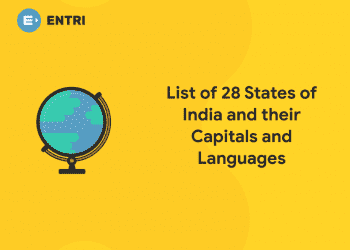
List of 28 States of India and their Capitals and Languages 2024 – PDF Download
List of government banks in india 2024: all you need to know, tnpsc group 2 posts and salary details 2022, ksda recruitment 2023 apply online for 9264 fda sda posts – qualification, new map of india with states and capitals 2024.

- Data Science Course
- Full Stack Developer Course
- Data Science Course in Malayalam
- Full Stack Developer Course in Malayalam
- Full Stack Developer Course in Hindi
- Full Stack Developer Course in Tamil
- Full Stack Developer Course in Telugu
- Full Stack Developer Course in Kannada
- Practical Accounting Course
- Stock Market Course
- Become a teacher
- Login to Entri Web
Spoken English Courses
- Spoken English Course
- Spoken English Course for Housewives
- Spoken English Course for Working Professionals
- Spoken English Course for School Students
- Spoken English Course for College Students
- Spoken English Course for Job Seekers
- AI Powered Spoken English Course
Quick Links
- Aptitude Questions
- Entri Daily Quiz Practice
- Current Affairs & GK
- News Capsule – eBook
- Preparation Tips
- Kerala PSC Gold
- Entri Skilling
Other Courses
- OET Coaching Classes
- Nurse Recruitment Abroad
- Montessori Teachers Training
- Oil and Gas Course Online
- Digital Marketing Course
- German Language A1 Course
- German Language A2 Course
- German Language B1 Course
- German Language B2 Course
Popular Exam
- Railway RRB Exam
- Tamil Nadu PSC
- Telangana PSC
- Andhra Pradesh PSC
- Staff Selection Commission Exam
© 2023 Entri.app - Privacy Policy | Terms of Service

IMAGES
VIDEO
COMMENTS
They write new content and verify and edit content received from contributors. Vikram Sarabhai (born August 12, 1919, Ahmadabad, India—died December 30, 1971, Kovalam) Indian physicist and industrialist who initiated space research and helped develop nuclear power in India. Sarabhai was born into a family of industrialists.
Vikram Ambalal Sarabhai Jain (12 August 1919 - 30 December 1971) was an Indian physicist and astronomer who initiated space research and helped to develop nuclear power in India. He was honoured with Padma Bhushan in 1966 and the Padma Vibhushan (posthumously) in 1972.
Dr. Vikram Ambalal Sarabhai was an Indian physicist and an astronomer who started the space research organization and initiated the nuclear power plant in India. Because of his achievement, he is regarded as the Father of the Indian space program. He was honoured with Padma Bhushan in 1966 and the Padma Vibhushan in 1972.
Fondly called the Father of the Indian Space program, Vikram Sarabhai was a man much ahead of his times. Born into a wealthy business family in India, he enjoyed a privileged childhood and the means to pursue all the education he wanted. From a young age Sarabhai developed a deep interest in science and mathematics.
Vikram Sarabhai (12 August 1919 - 30 December 1971) was one of the greatest scientists in India. He is renowned as the Father of the Indian space program, encompassing roles of a scientist, innovator, industrialist, and visionary. His contributions extended to establishing the Physical Research Laboratory (PRL) and chairing the Atomic Energy ...
After a brief conversation with fellow space researcher Avul Pakir Jainulabdeen Abdul Kalam (who would later be President of India), Sarabhai died of a heart attack aged 52. For his service to independent India, Sarabhai was awarded two of the country's highest honours: the Padma Bhushan in 1966, and the Padma Vibhushan, awarded posthumously ...
He initiated India's space programme, which today is renowned all over the world. Dr Vikram Sarabhai received the Shanti Swarup Bhatnagar Medal in 1962. The nation honoured him awarding Padma Bhushan in 1966 and Padma Vibhushan (posthumously) in 1972. Vikram Sarabhai passed away in his sleep on December 31, 1971. Right to Information.
Dr. Vikram Sarabhai was born on 12 August 1919 in Ahmedabad, Gujarat. Dr. Vikram A Sarabhai obtained his Tripos (1939) and Ph. D. (1947) in Cosmic Ray Physics from Cambridge University, U.K. He worked with Sir C.V.Raman, the Nobel Laureate, at the Indian Institute of Science, Bangalore. On his return from Cambridge, Dr. Sarabhai set up the ...
Indian physicist and astronomer Vikram Sarabhai (1919-1971) Amrita Shah. UPDATED: Aug 10, 2022 19:10 IST. At the age of 11 or so, Vikram Sarabhai was said to have been fond of setting a challenge for himself: riding a bicycle which he would pedal as fast as he could. When it had achieved a satisfactory momentum, he would cross his arms over his ...
Vikram Sarabhai Space Centre, Thiruvananthapuram. Space Applications Centre, Ahmedabad (This institution came into existence after merging six institutions/centres established by Sarabhai) Faster Breeder Test Reactor (FBTR), Kalpakkam. Variable Energy Cyclotron Project, Calcutta. Electronics Corporation of India Limited (ECIL), Hyderabad
Vikram Sarabhai: Birth, Early Life, Education. Vikram Ambalal Sarabhai was born on August 12, 1919, to Ambalal Sarabhai and Saraladevi. The couple had eight children-- 5 daughters and 3 sons.
Vikram Ambalal Sarabhai born on August 12, 1919, in Ahmadabad and died December 30, 1971, Kovalam. He was born into a family of industrialists. He earned his doctorate from the University of Cambridge, England. After moving to India during World War II, he undertook research in cosmic rays under physicist Sir Chandrasekhara Venkata Raman at the ...
Test Series. Vikram Sarabhai, a distinguished physicist and the driving force behind space research in India, has left an indelible mark on the country's scientific landscape. Recognised as the "Father of the Indian Space Program", his significant contributions have fostered a deep respect for science and the scientific community among Indians.
Vikram Sarabhai, a renowned scientist, made a lasting impact on India's scientific scene by spearheading space research. Known as the "Father of the Indian Space Program," his valuable contributions have instilled a deep appreciation for science and the scientific community among Indians. Sarabhai's life was a mix of a strong love for science and a lasting interest in diverse fields ...
Same with satellites'.". Joshi went on to co-author his biography, Vikram Sarabhai — India's Space Pioneer. Giving flight to Sarabhai's dream of probing the atmospheric regions for space research, was the first sounding rocket that was launched from Thumba, in Kerala, in 1967. "He was already talking of launching satellites in 1969.
Vikram Sarabhai, A Life by Amrita Shah was published in 2007. It is reviewed today to commemorate Dr. Sarabhai's birthday which falls on 12 August. The Millennial Matriarchs both count Ahmedabad as home and have worked in institutions which were part of Vikrambhai's dream. I had the additional good fortune of living on the campus of IIM ...
Vikram Sarabhai Biography for UPSC. The pioneer of Space research in India and a notable physicist, Vikram Sarabhai, has made remarkable contributions to the astronomical and nuclear fields of India. Known as the "Father of the Indian Space Program", his contributions have created a profuse reverence in Indians for science and the ...
Vikram Sarabhai was born on 12 August 1919 in Ahmedabad, Gujarat state in western India, and he passed away on 30 December 1971, at 52 years of age. Vikram Sarabhai is a name that Indians will always have immense respect for. In today's age, we enjoy cricket matches from the comfort of our homes, get […]
The Vikram Sarabhai Space Centre (VSSC) is a major space research facility of the Indian Space Research Organisation (ISRO), focusing on rockets and space vehicles for India's satellite program. It is located in Thiruvananthapuram, Kerala, India. Vikram Sarabhai was an Indian physicist and astronomer, often referred to as the "Father of the ...
Vikram Sarabhai (1919-71), the renaissance man of Indian science, thought up the impossible and often made it happen. Founder of India's space programme (ISRO), Vikram dreamed of communication satellites that would educate people at a time when even a modest rocket programme seemed daring; of huge agricultural complexes serviced by atomic power and desalinated sea water.
Vikram A. Sarabhai — In 1943, Vikram Ambalal Sarabhai, who was then hardly 23, went to the Himalayas in Kashmir to study cosmic rays. at high altitude.. He was so thrilled that he decided to set up a laboratory to study cosmic rays. On his return from the United Kingdom with a Ph.D., he founded the Physical Research Laboratory in Ahmedabad, an institution devoted to the study of cosmic rays ...
2019 is the birth centenary of Vikram Sarabhai, the founder of India's space programme, who was born in Ahmedabad on 12 August 1919. Sarabhai, pursuing his studies at Cambridge when WWII broke out, returned to India to work with CV Raman at IISc, where he also met Homi J Bhabha. In these excerpts from her book Vikram Sarabhai: A Life, Amrita ...
Vikram Ambalal Sarabhai was the man who spearheaded India's space programme and he is considered as the Father of the Indian space program, Who Orchestrated The First Satellite Launch In The Country.He was born on 12 August 1919 in Ahmedabad, Bombay Presidency. He is popular across the country for establishing the Indian National Committee for Space Research (INCOSPAR), which was renamed ...